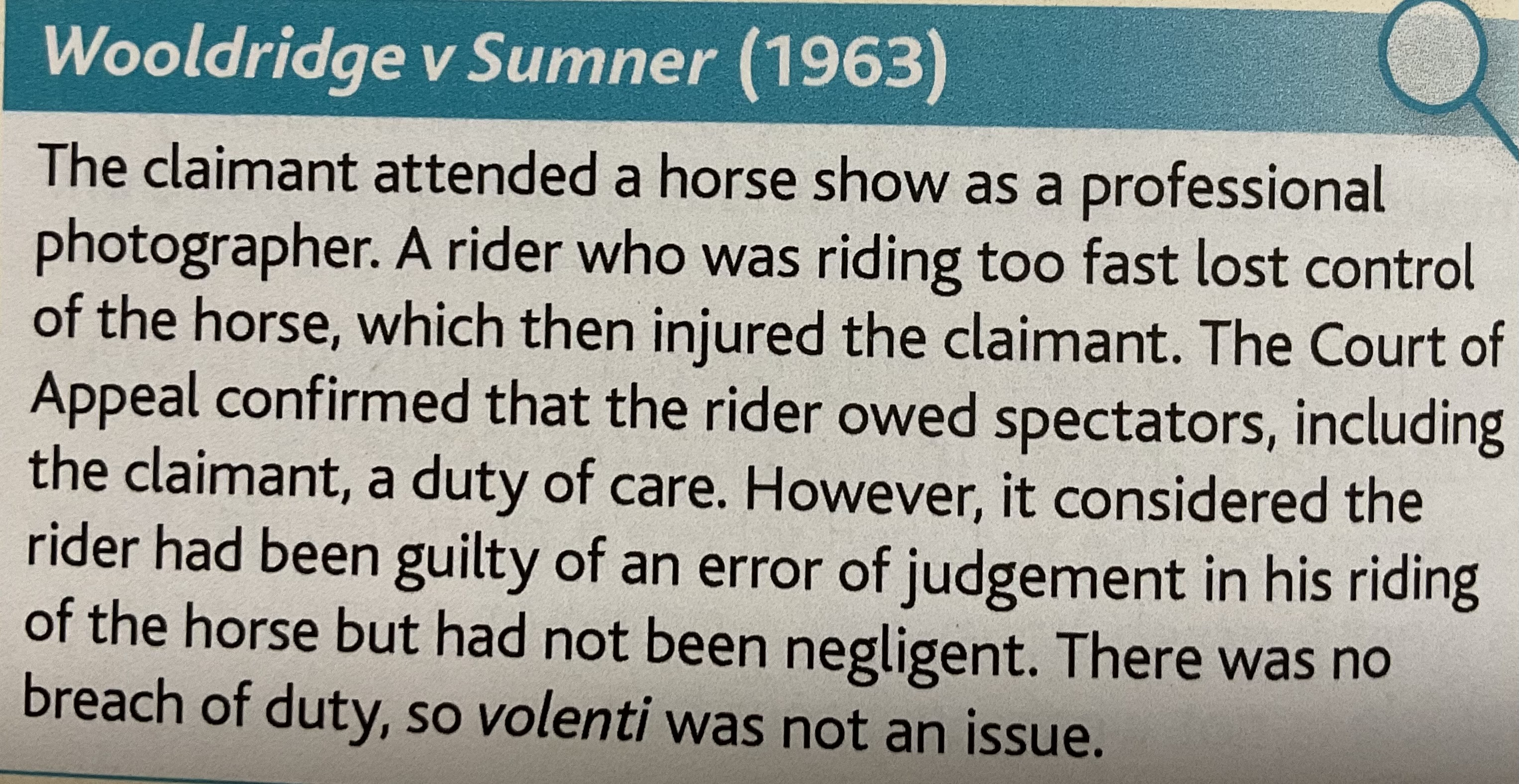liabilty in negigence: personal injury and damge to property
1/48
There's no tags or description
Looks like no tags are added yet.
Name | Mastery | Learn | Test | Matching | Spaced |
|---|
No study sessions yet.
49 Terms
Neighbour principle
The person who is owed a duty of care by the d. It is anyone you ought to have in mind who might potentially be inured by your act or omission
Evolved over time to three part test set out by a pro v dickman 1990
Was the damage reasonably foreseeable
Is ther sufficiently proximate relationship between the claimant and the defendant
Is it fair just ad reasonable to impose a duty
Donahue v Stevenson 1932
Mrs. Donahue went to a café with her friend. The friend bought her a drink of ginger beer and ice cream. The bottle of ginger beer had dark glass so that its contents could not be seen after drinking some of it. Mrs Donahue poured the rest out and then saw that contained a dead and decomposing snail Because of the impurities in the drink. She suffered both physical and psychological injuries. She wanted to claim her injuries as she had not bought the drink, she could not use the law of contract to see the café or the manufacturer. She sued the manufacturer in negligence claiming that there were a fault in the manufacturing process that they owe her duty of care in the House of Lords load Atkins set the test for one person with our duty to another he said he must take reasonable care to avoid ax or emissions which you can reasonably foresee would be likely to end your neighbour.
Caparo v Dickman 1990
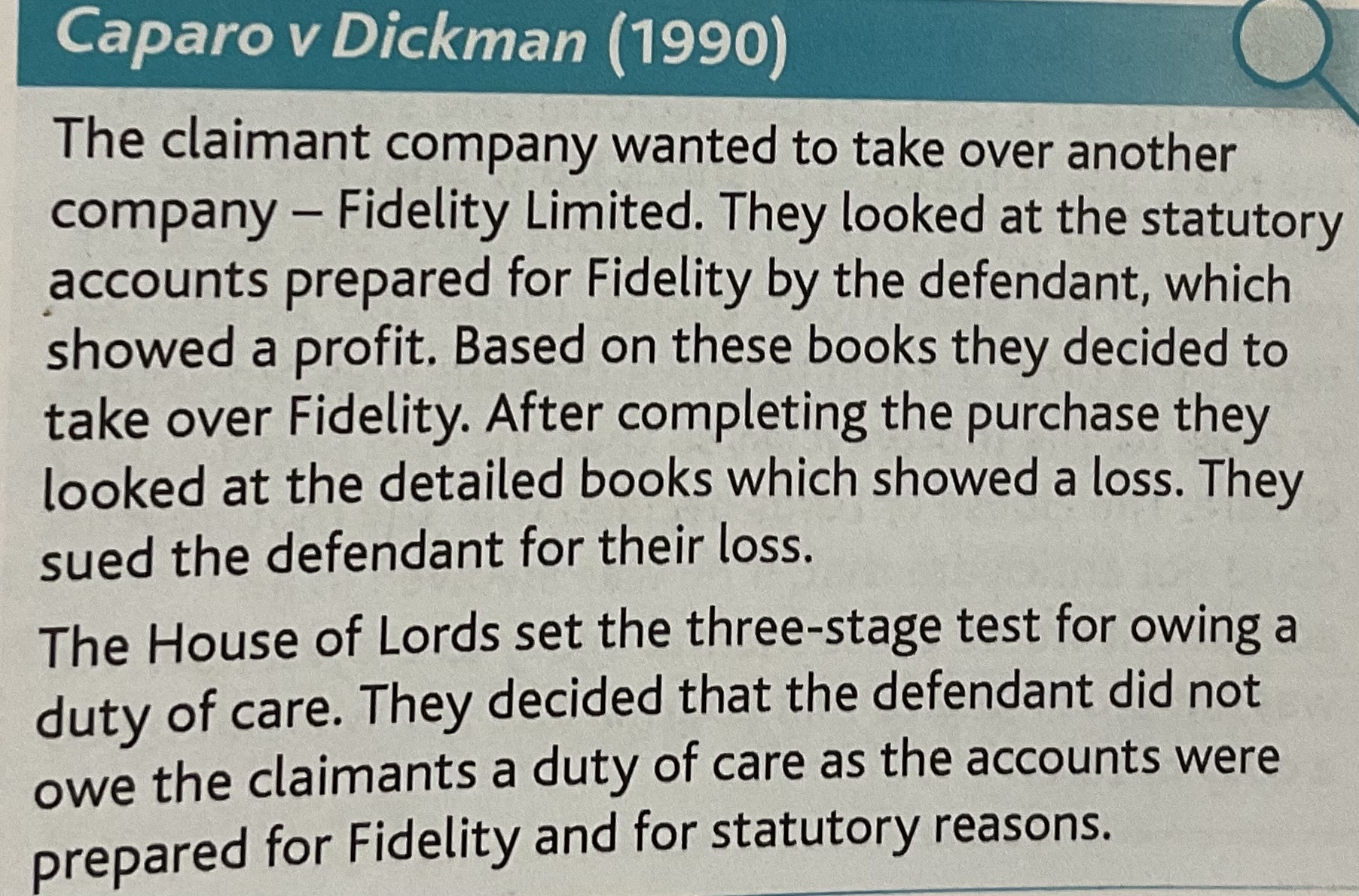
Damage or harm reasonably foreseeable
Could foresee their actions or omissions could cause damage or injury
E.g Kent v Griffith 2000
Kent v Griffifs 2000
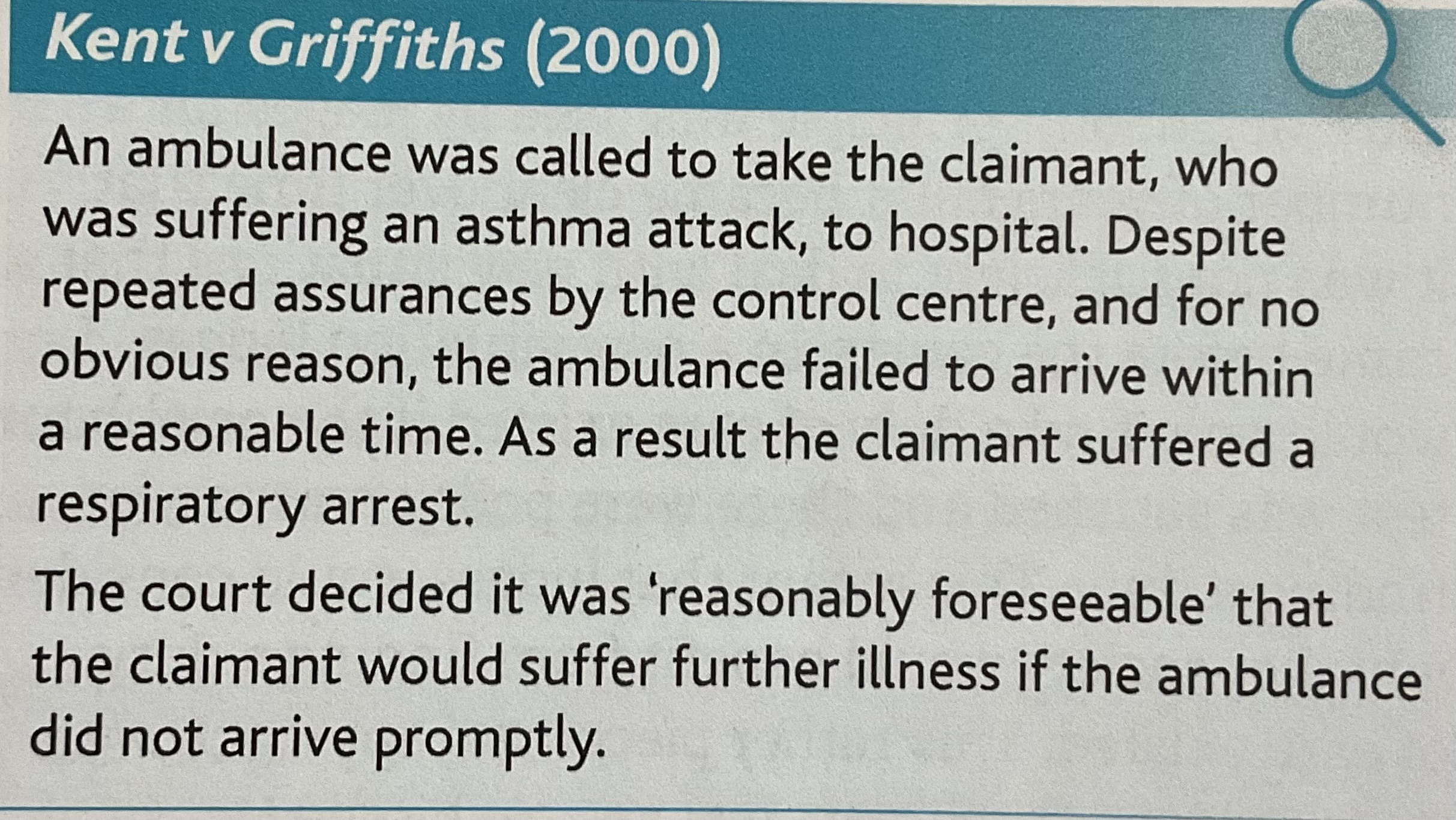
Bourhillv young 1943 (proximate)
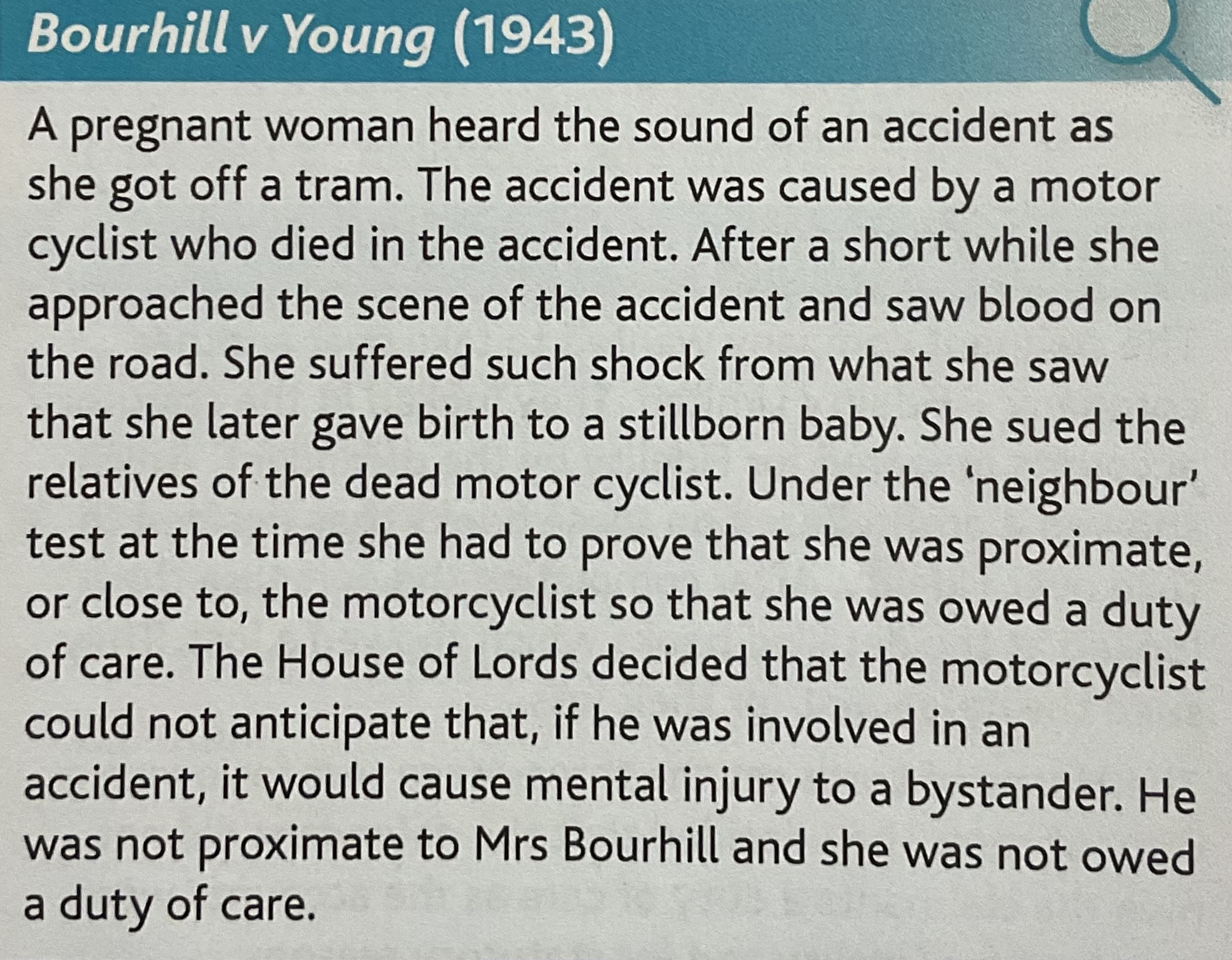
McLoughlin v O’Brien 1982
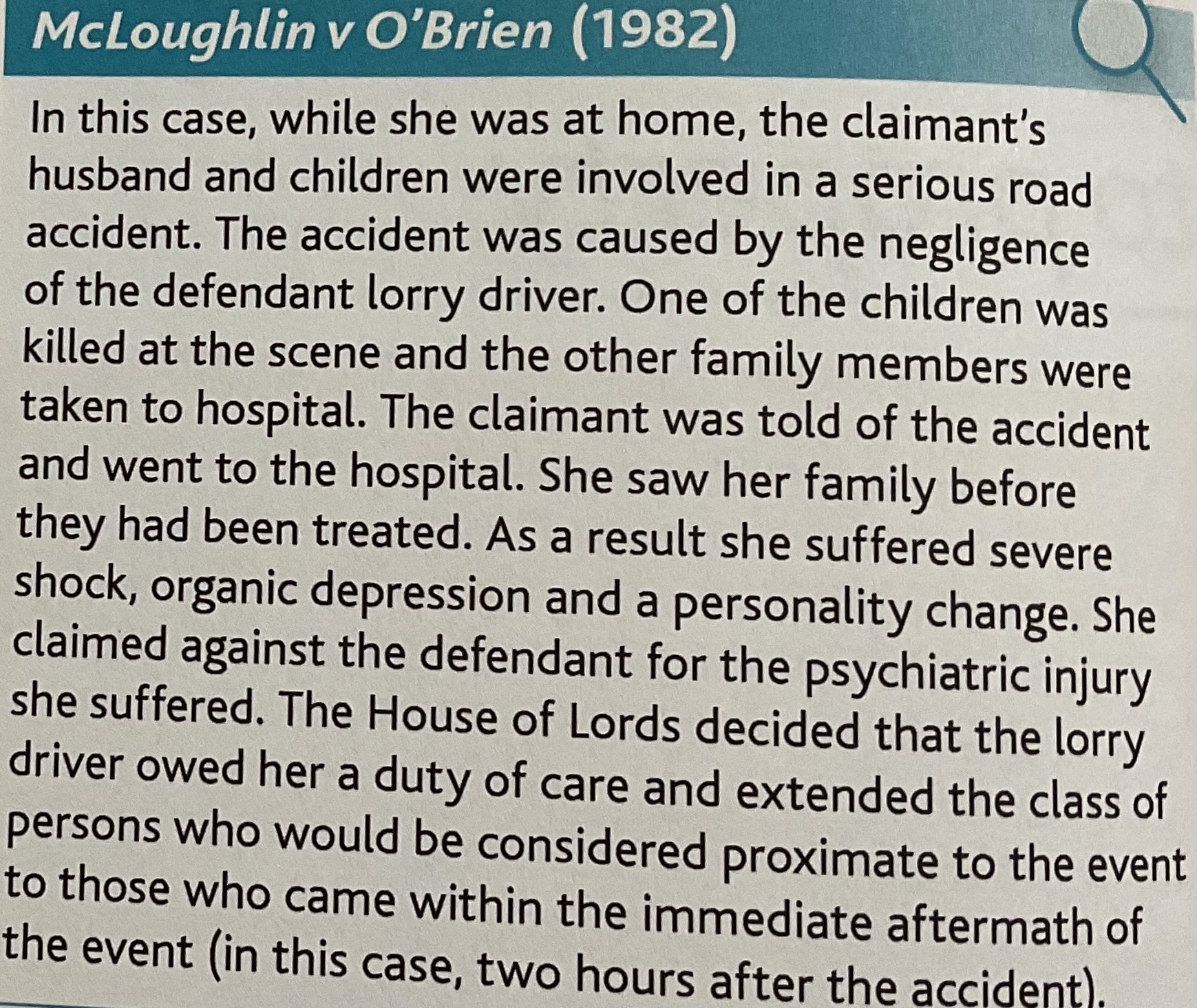
Fair just and reasonable to impose a duty
To consider if best for society as a whole and wether or not ill open floodgates
Hill v chief constable of West Yorkshire 1990- pointed out that imposing a duty of care on police could lead to policing being carried out in a defensive way might divert their attentions and resources away from prevention of crime and likely to lead to lower levels of policing not higher ones
Hill v Chief constable of West Yorkshire 1990
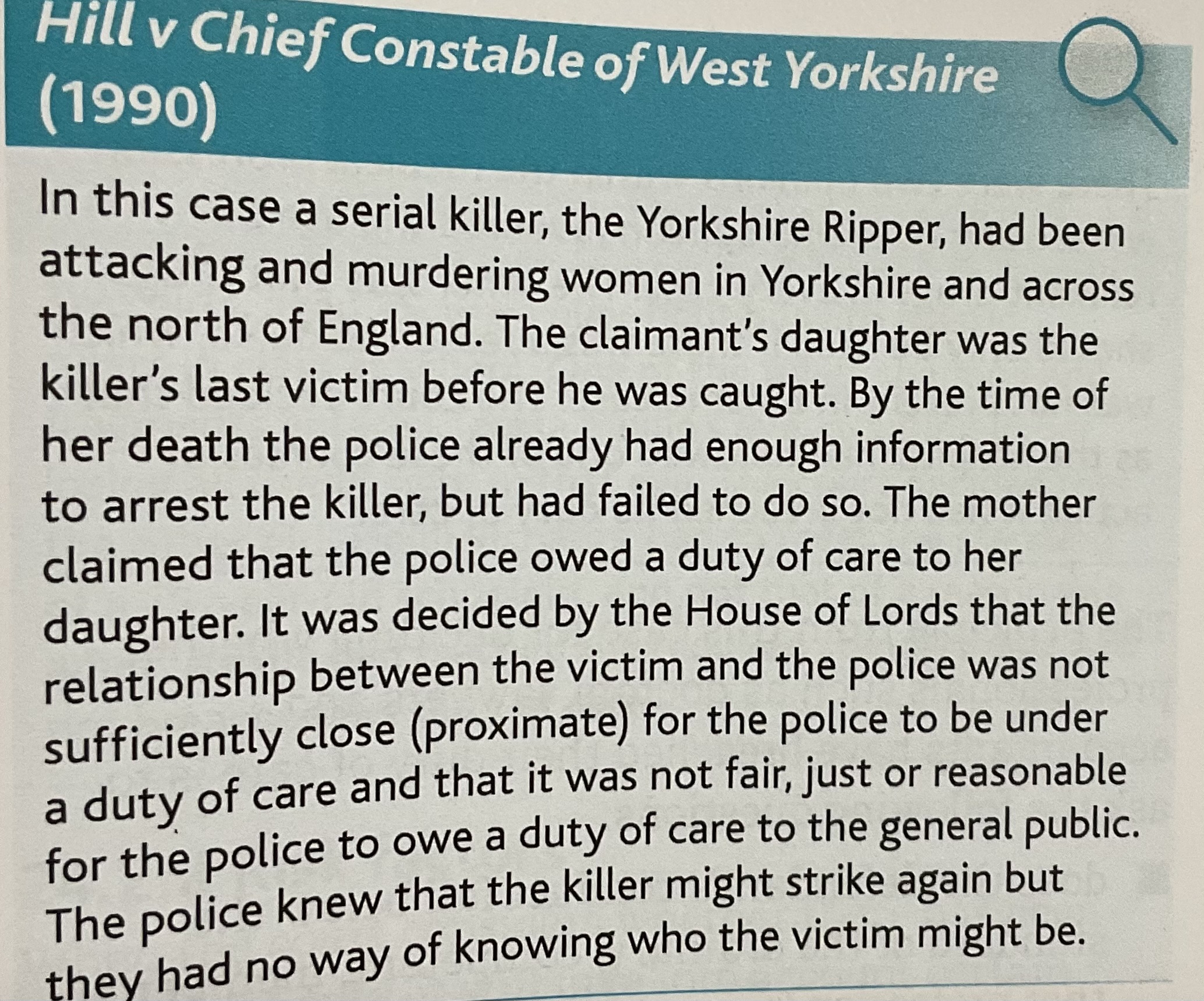
Breach of duty the objective standard of care
Once shown that a duty of care is owed Claimant has to prove that the GT of care has been broken by failing to reach their acquired standard of care. The standard is objective part of the reasonable person.
Reasonable person
Considered to be the ordinary person in the street or doing a task
Professionals are judged by the standard of the profession as a whole
Learners judged at standard of the competent more experienced person
For children and young people the standard is that of a reasonable person of d’s age at time of accident
Bolam v Freire Barnet hospital management committee 1957
In this case the claimant was suffering from mental illness and the treatment at the time was to be given a type of electric shock. ECT he signed a consent form but what’s not told of the risk of broken bones while receiving the shocks and was not given relaxant drugs he suffered a broken pelvis while receiving the treatment. There were two opinions within the medical profession when using ECT one opinion favoured the use of relaxing drugs in every case the other was that drug should only be used if there was a reason to do so which was not present in Boland‘s case the court decided that as the hospital followed one of these courses of action it is not preached his duty of care.
Principles from Bolam
does the d’s conduct fall below the standard of the ordinary competent member of that profession
Is there a substantial body of opinion within the profession that would support the course of action taken by the d
Nettleship v Weston 1971
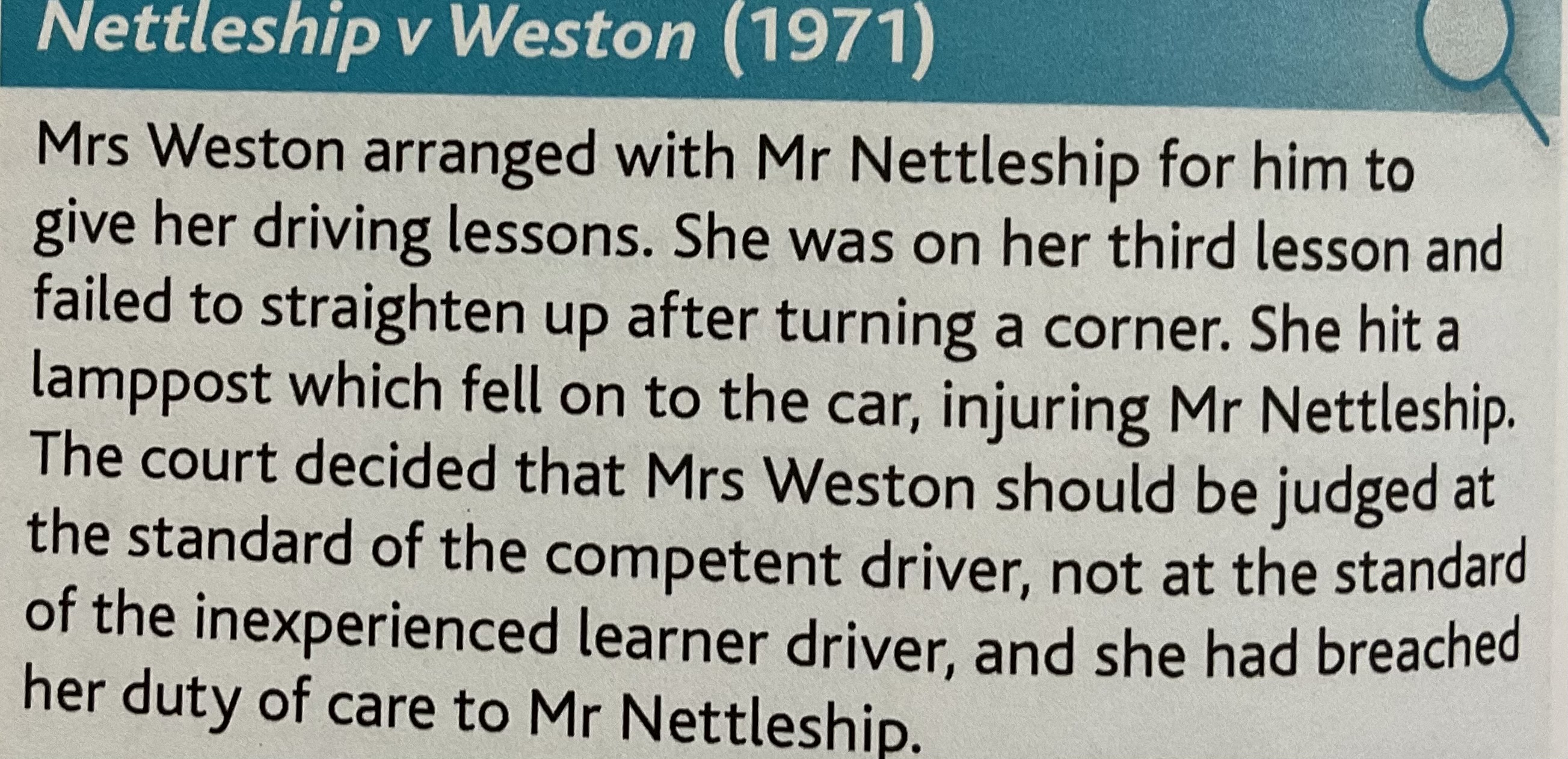
Mullin v Richard’s 1998
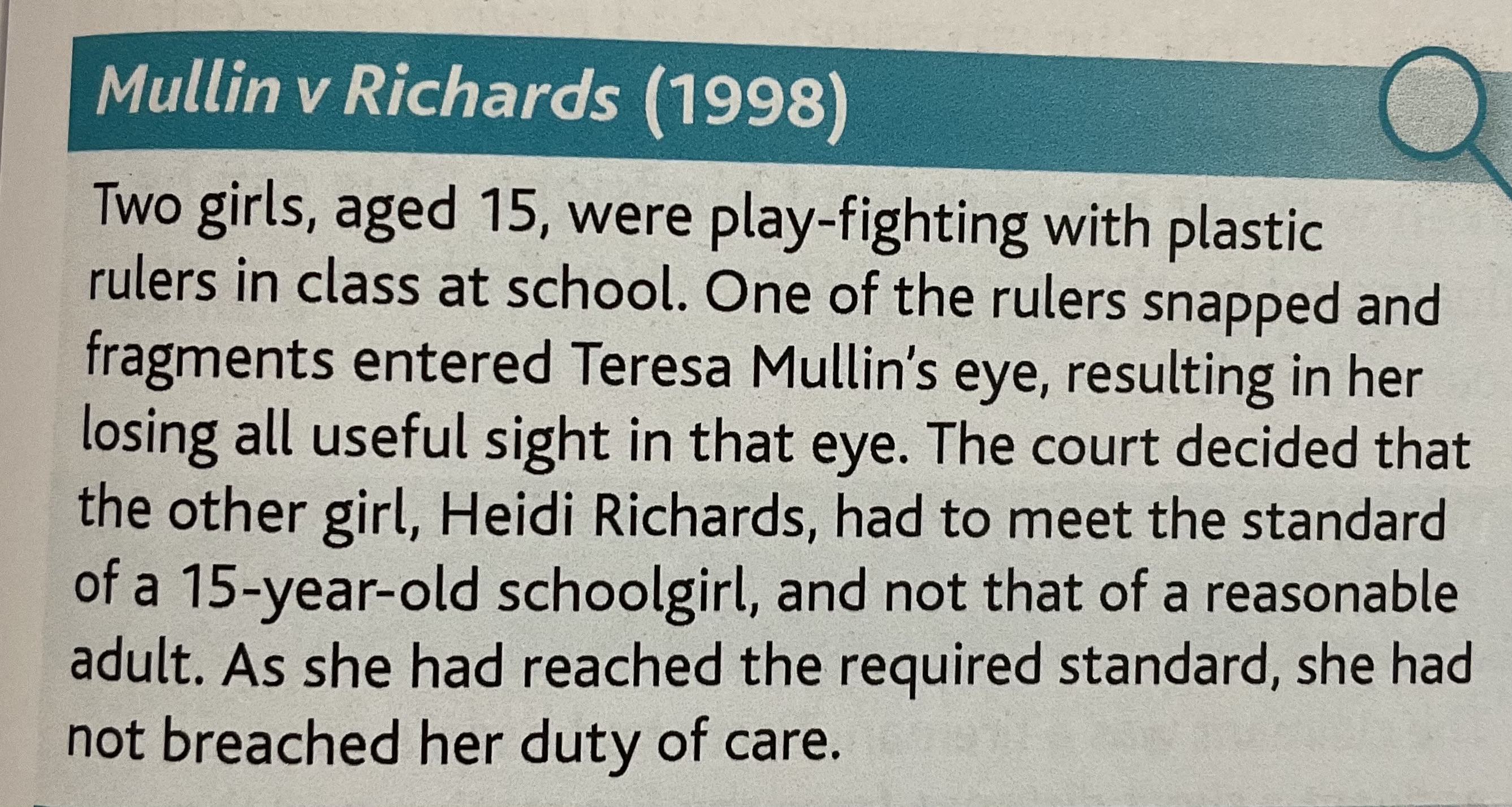
Risk factors
Would the reasonable person take more or fewer risks in same situation
Has the claimant any special characteristics which should be taken account of
What is the size of the risk
Have all appropriate precautions taken place
We’re the risks known about at the time of the accident
Is there any public benefit to taking the risk
Special characteristics -Paris v Stepney borough council 1951
Employers knew that the consequences of an injury to a good eye would be very serious. They should’ve taken greater care because of this and provided him with goggles even though at the time it was not thought necessary to provide goggles for other workers also the cost and effort of providing goggles was very small compared to the consequence of the risk.
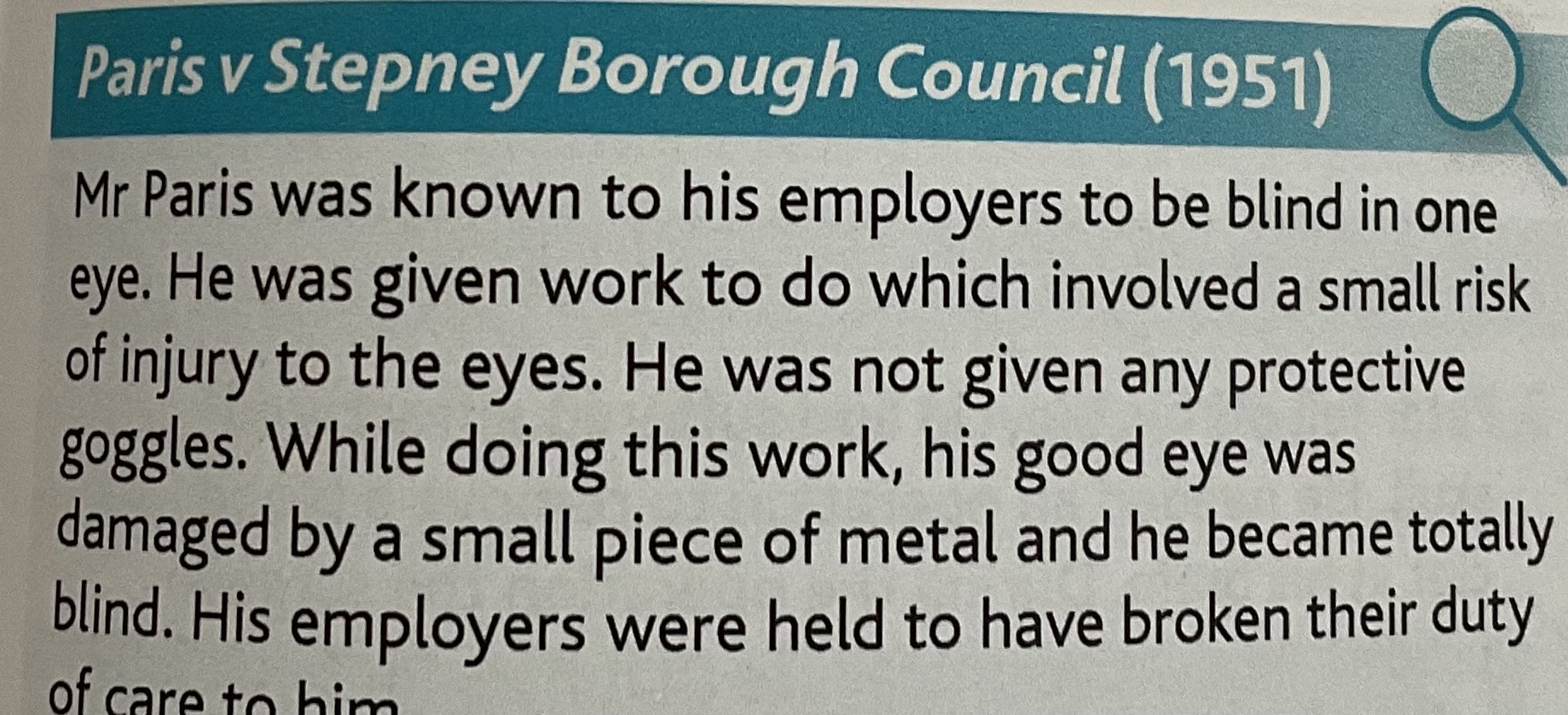
Size of risk
Higher the risk of injury the greater the precautions needed to be taken
Higher risk of injury the higher the standard of care
Bolton v stone 1951
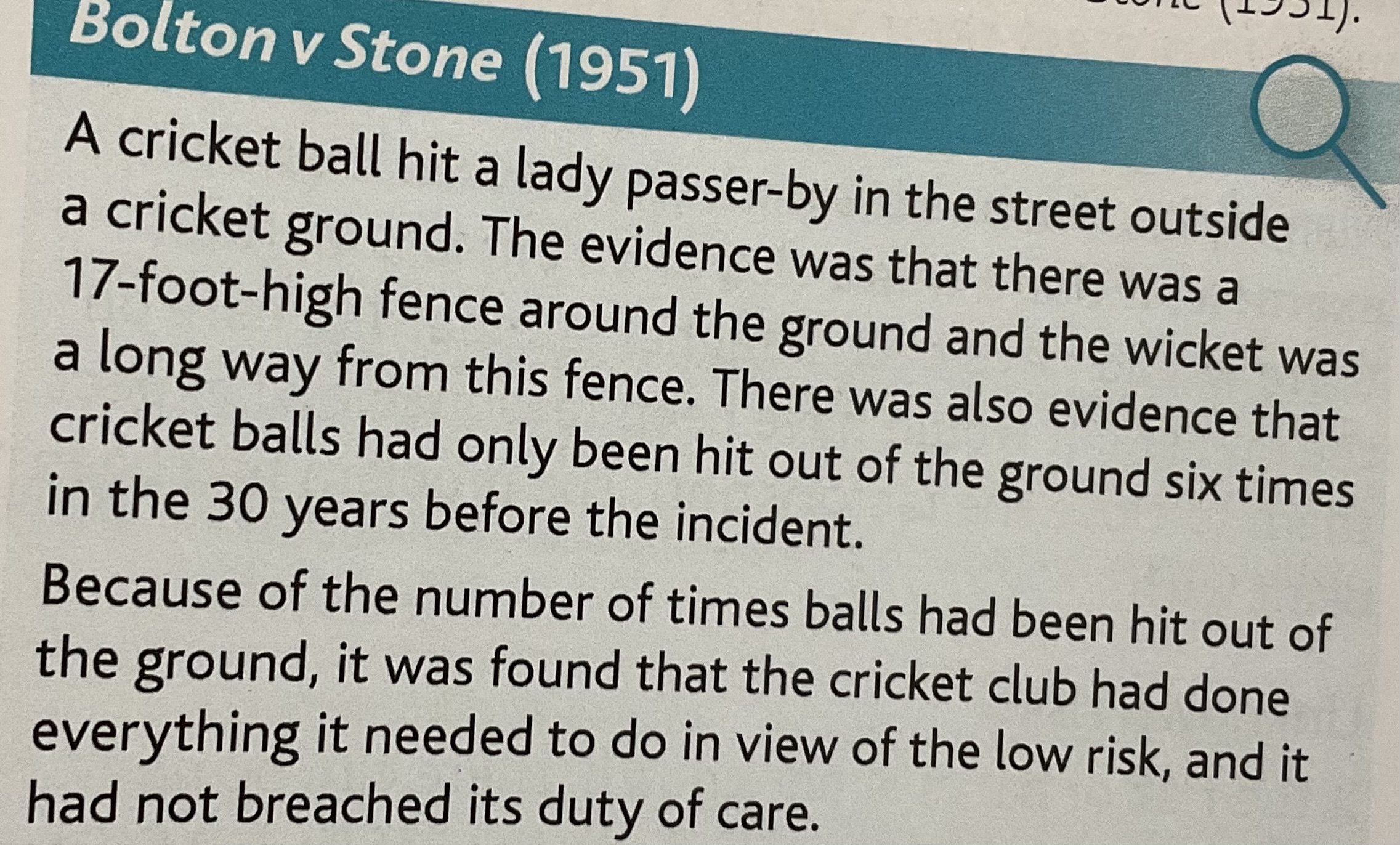
Haley v London electricity board 1965
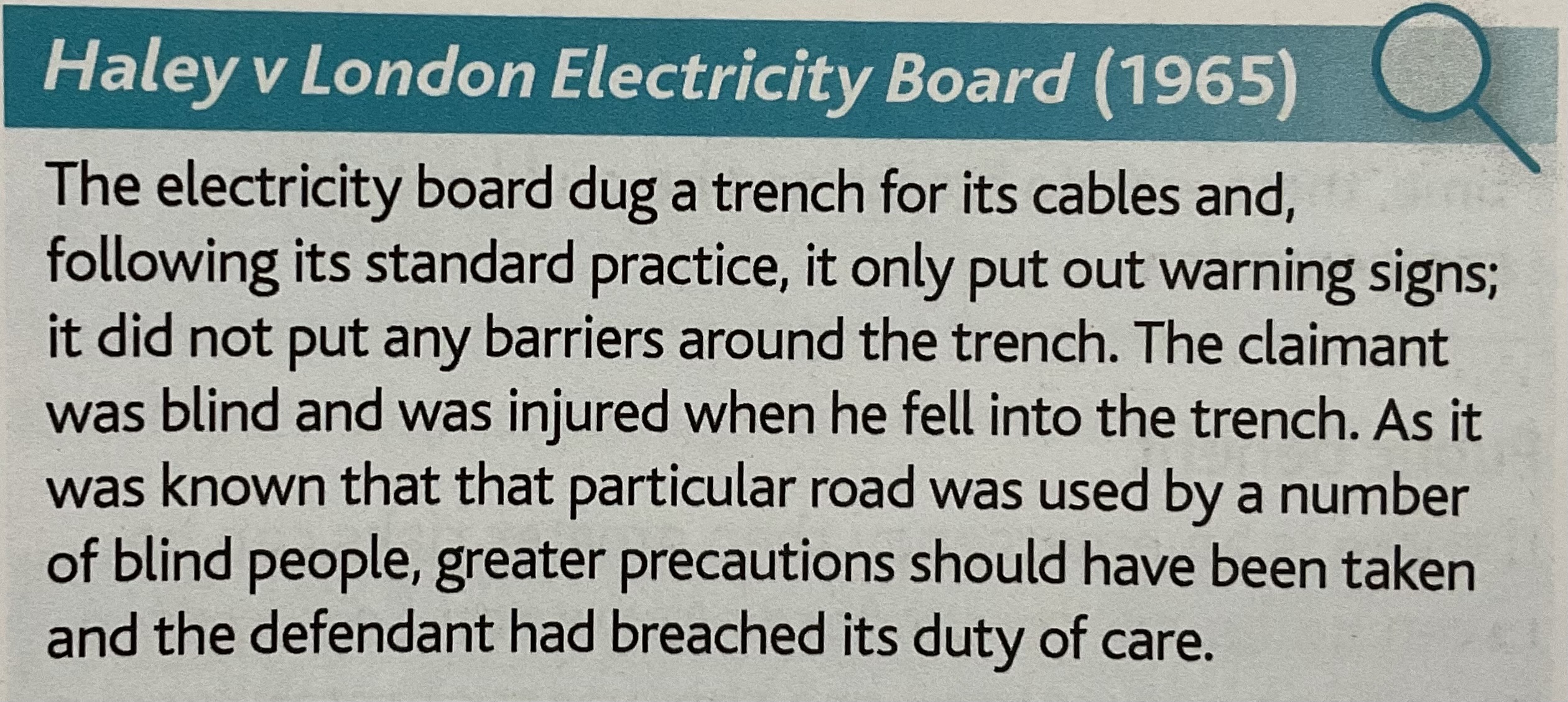
Appropriate precautions
Balance or risk involved against the cost
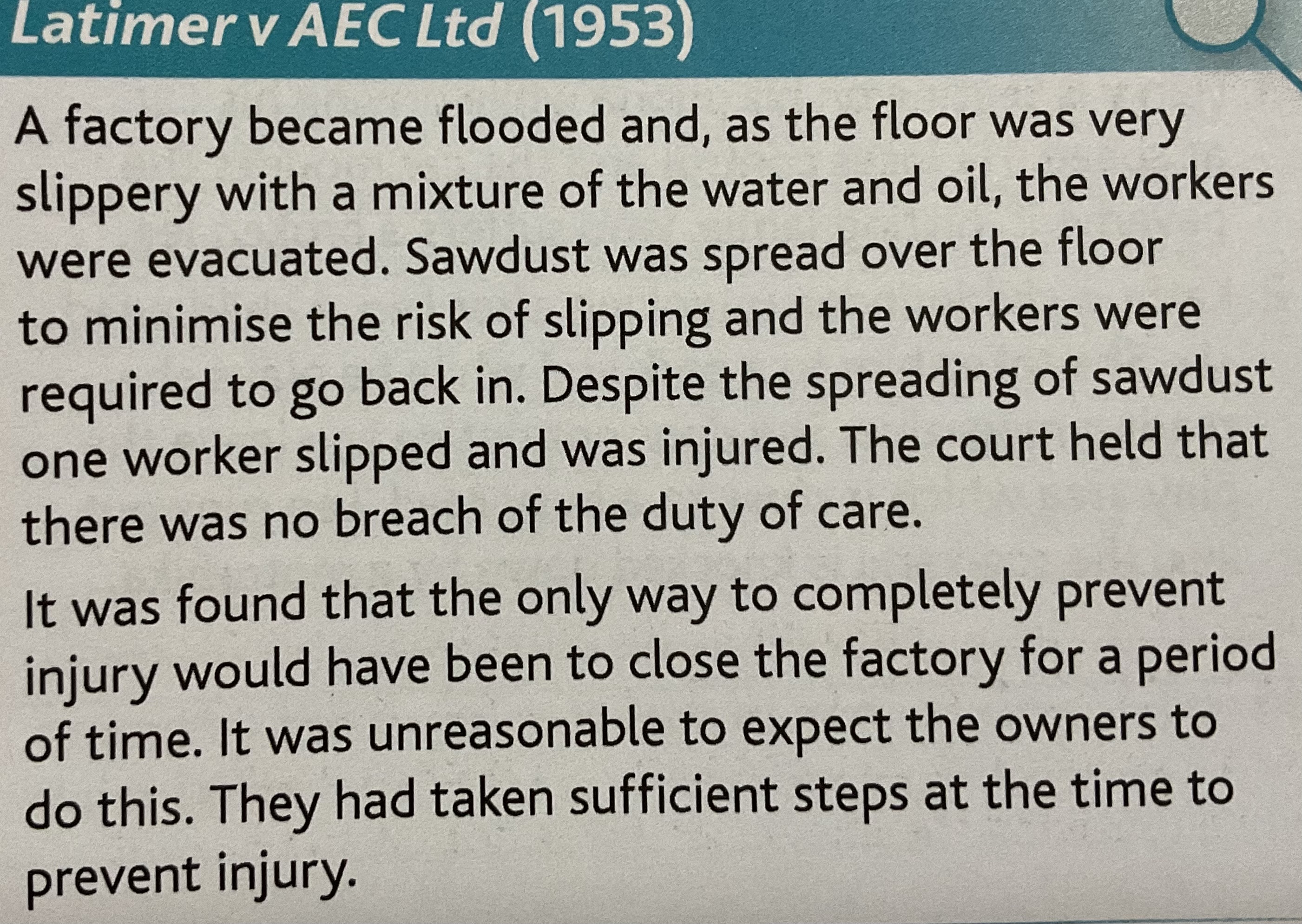
Unknown risks
If the risk of harm is not known there can be no breach
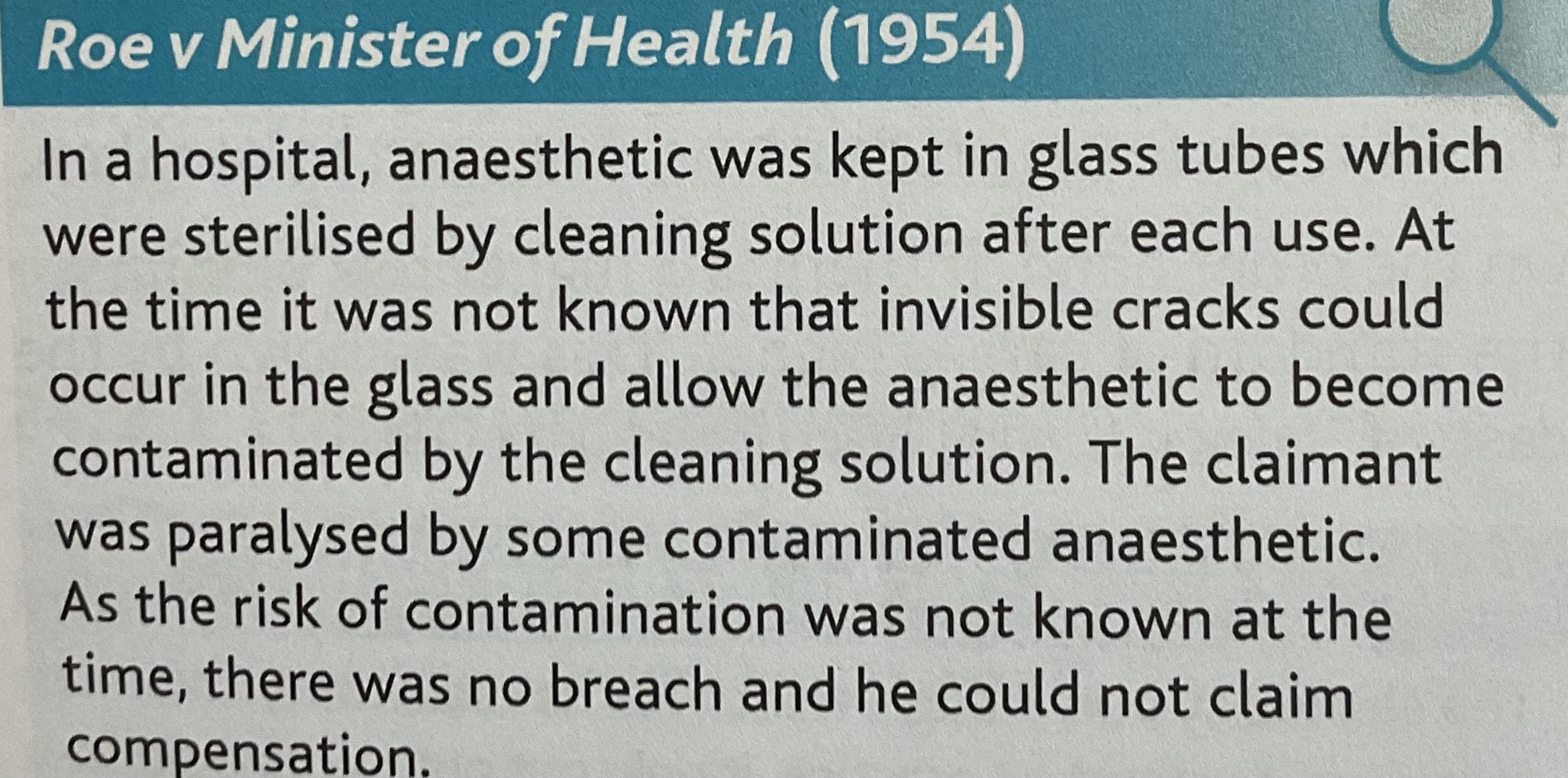
Public benefit
If there is an emergency then greater risks can be taken and a lower standard of care can be accapeted
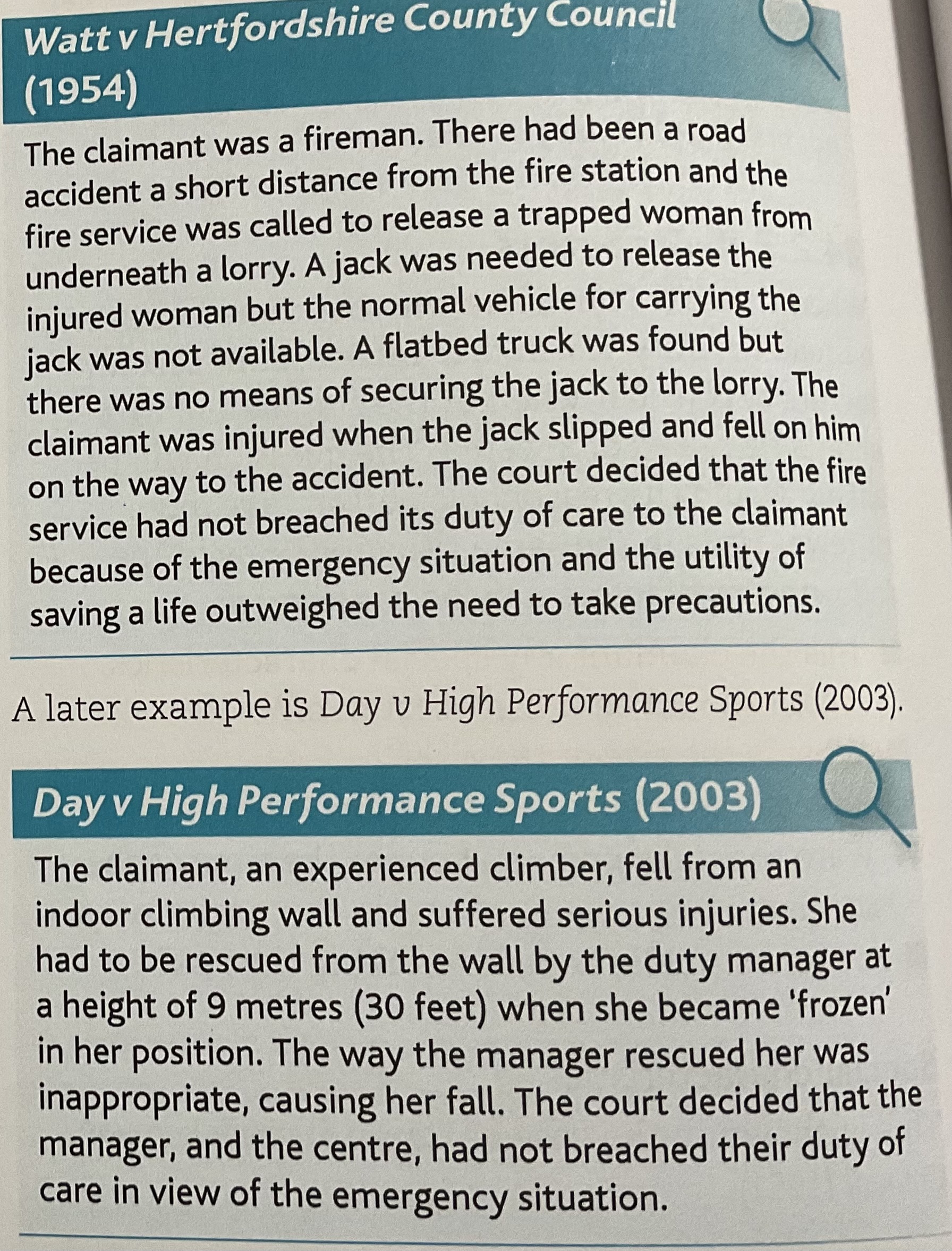
Damage
Legal concept has the defendants breach of duty led to injury or property damage suffered by the claimant
2 parts
Causation- breach of duty has caused injury etc (factual causation)
Causation in law decides if injury or damage suffered was reasonably foreseeable
Both elects need to be proved
Causation
Link between d’s act or Morison and the injury,loss or damage caused to claimant
Factual causation decided by but for test
Intervening acts (no us actus interviews) can break chain of causation
Barnett v Chelsea and Kensington Hospital Management committee 1969
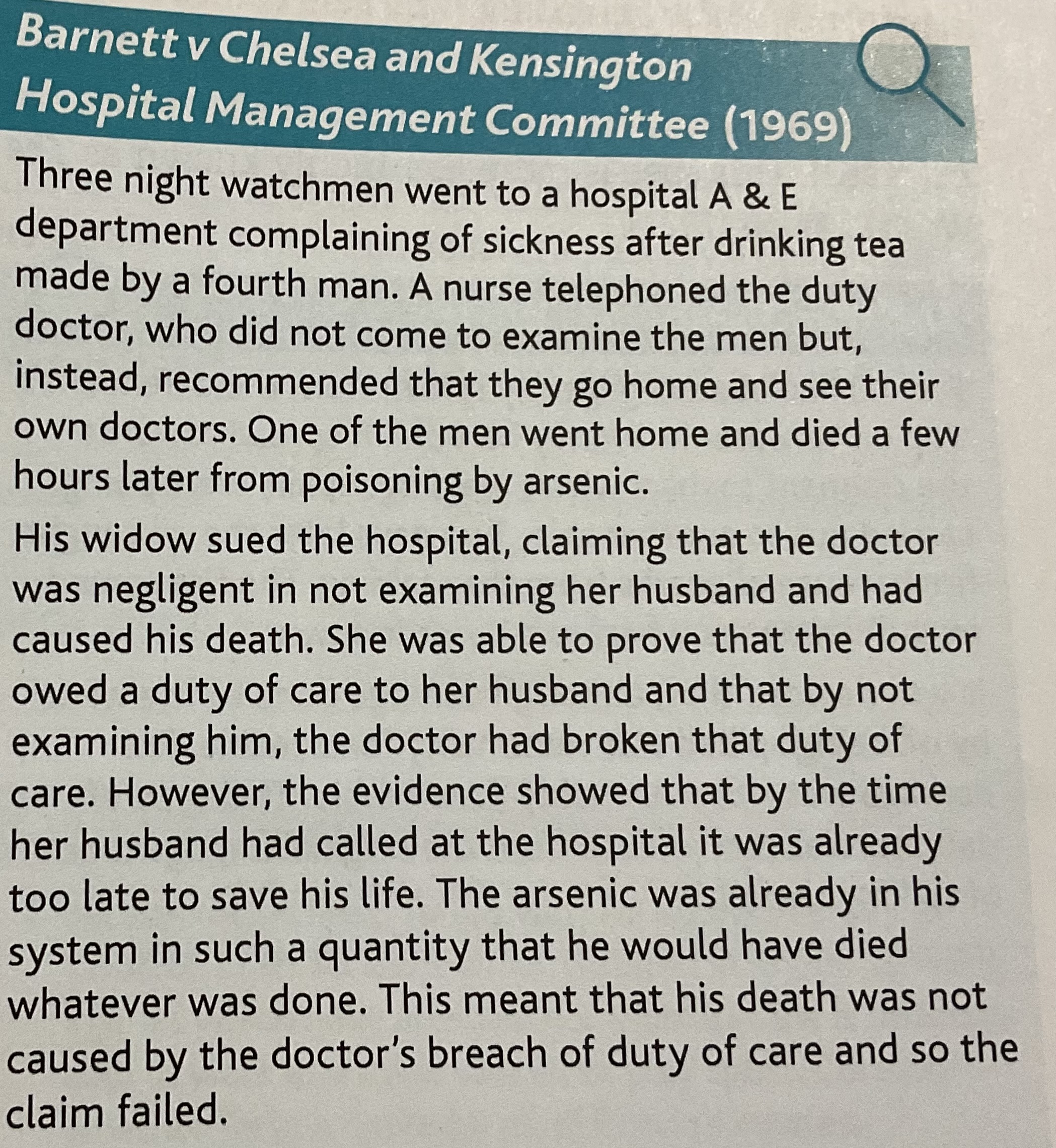
Remoteness of damage
Must be proved that the damage is not too remote from the negligence comes from wagon mound case
Must be reasonably foreseeable
The wagon mound 1961
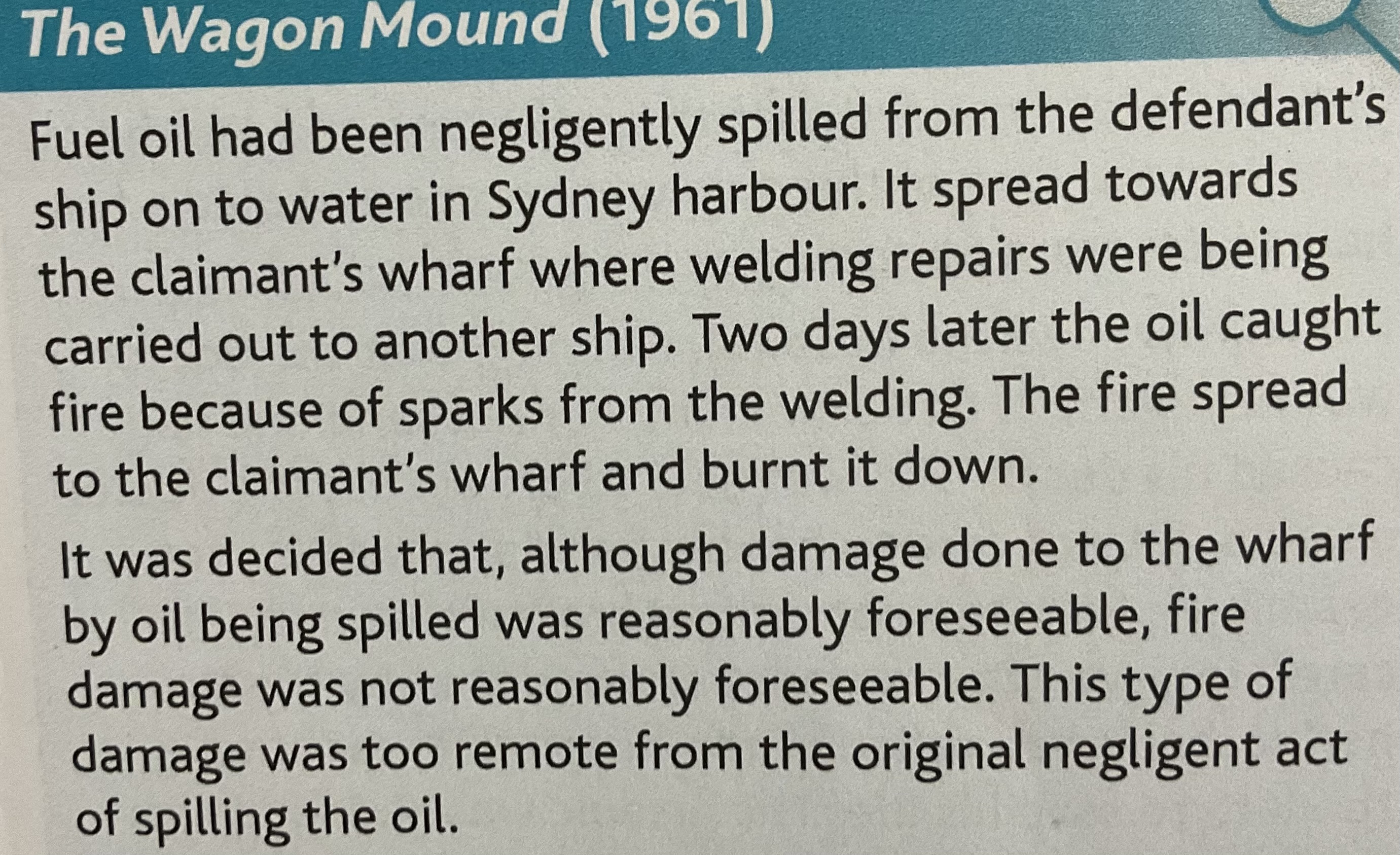
Type of injury foreseeable
D liable if type of injury foreseeable even if precise way it happened wasn’t
Hughes v Lord advocate 1963
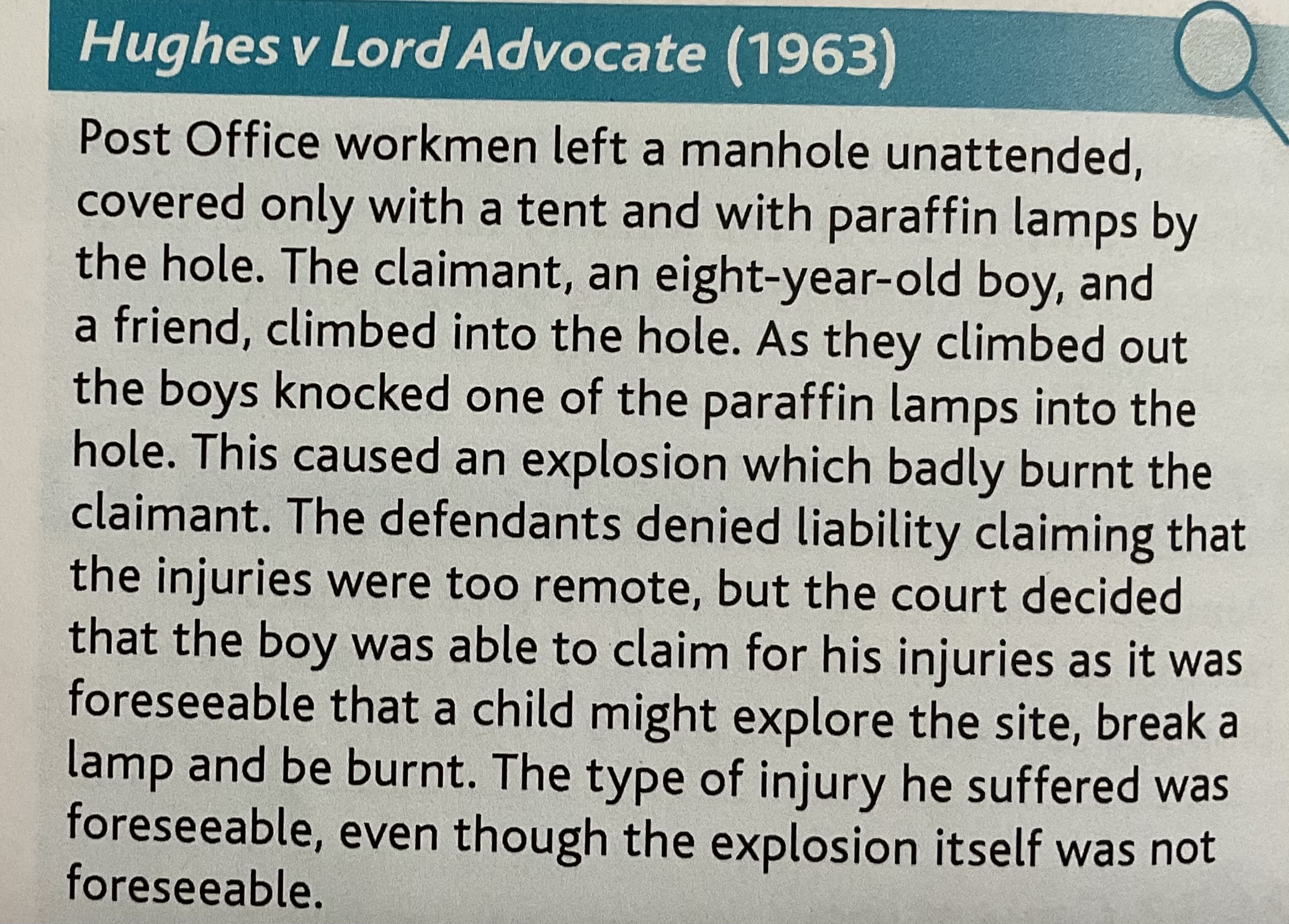
Bradford v Robinson rentals 1967
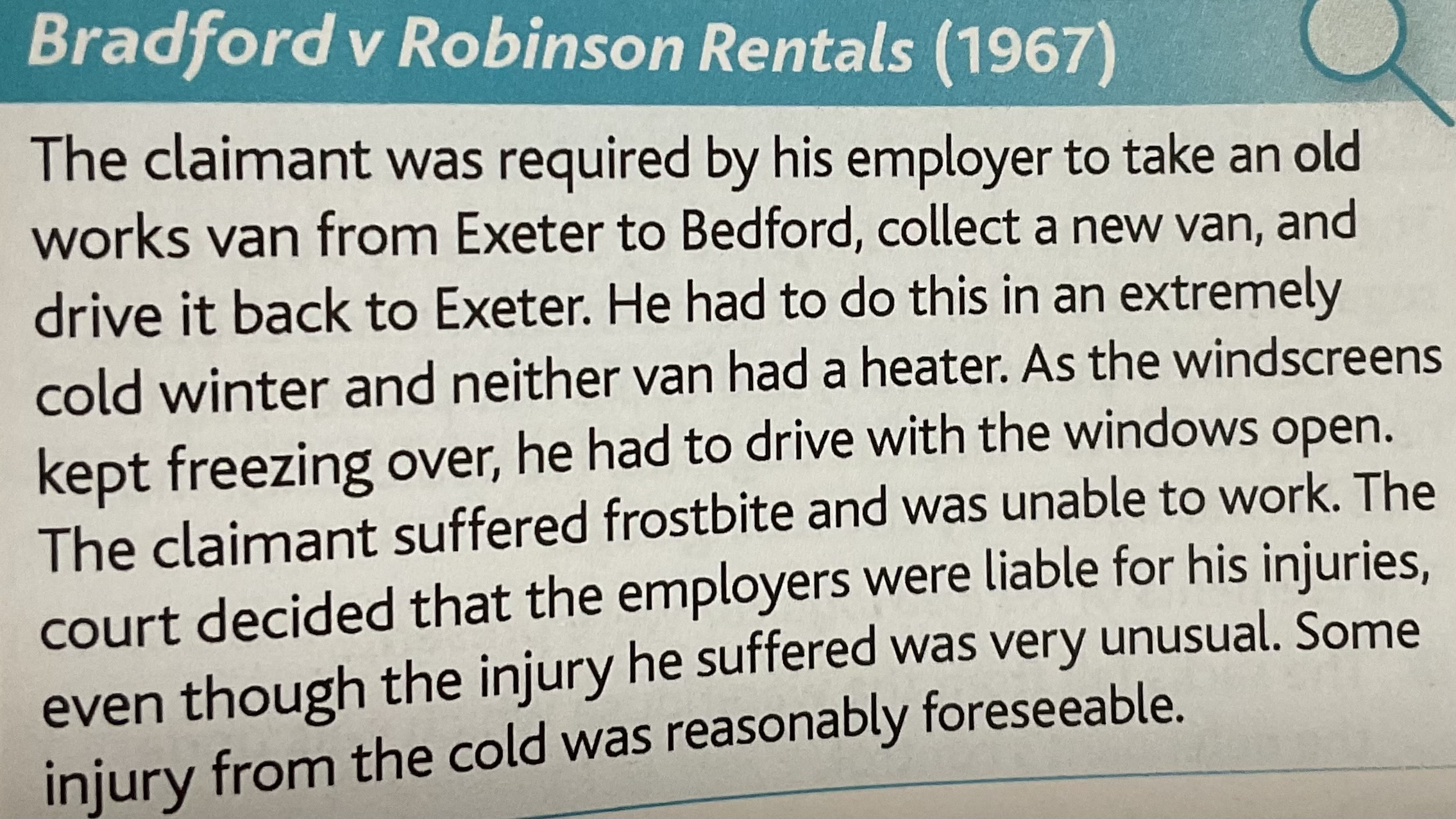
Doughty v turner asbestos 1964
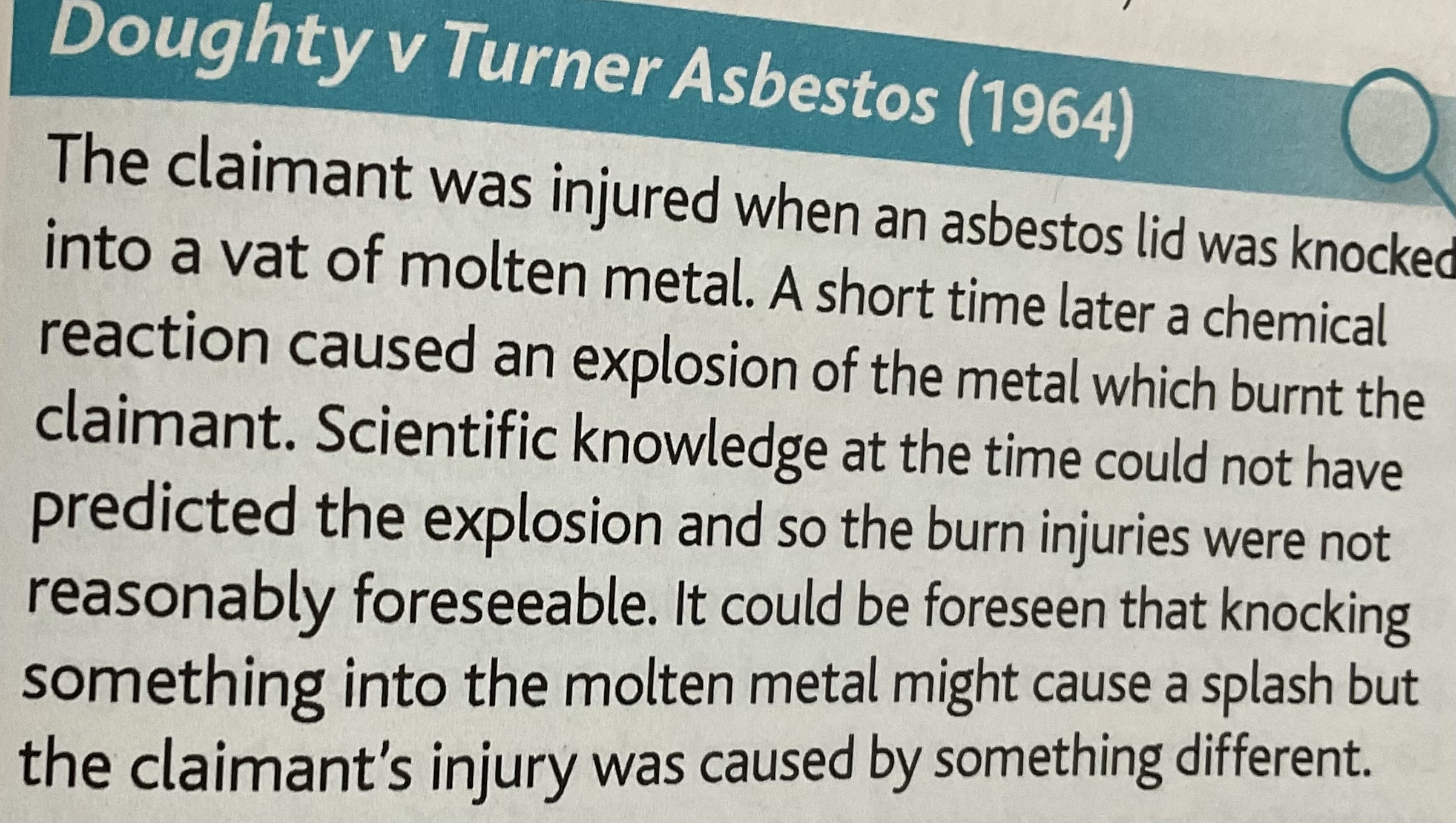
Take your victim as you find them
In civil known as eggshell skull rule
Smith v Leech brain and co. 1962
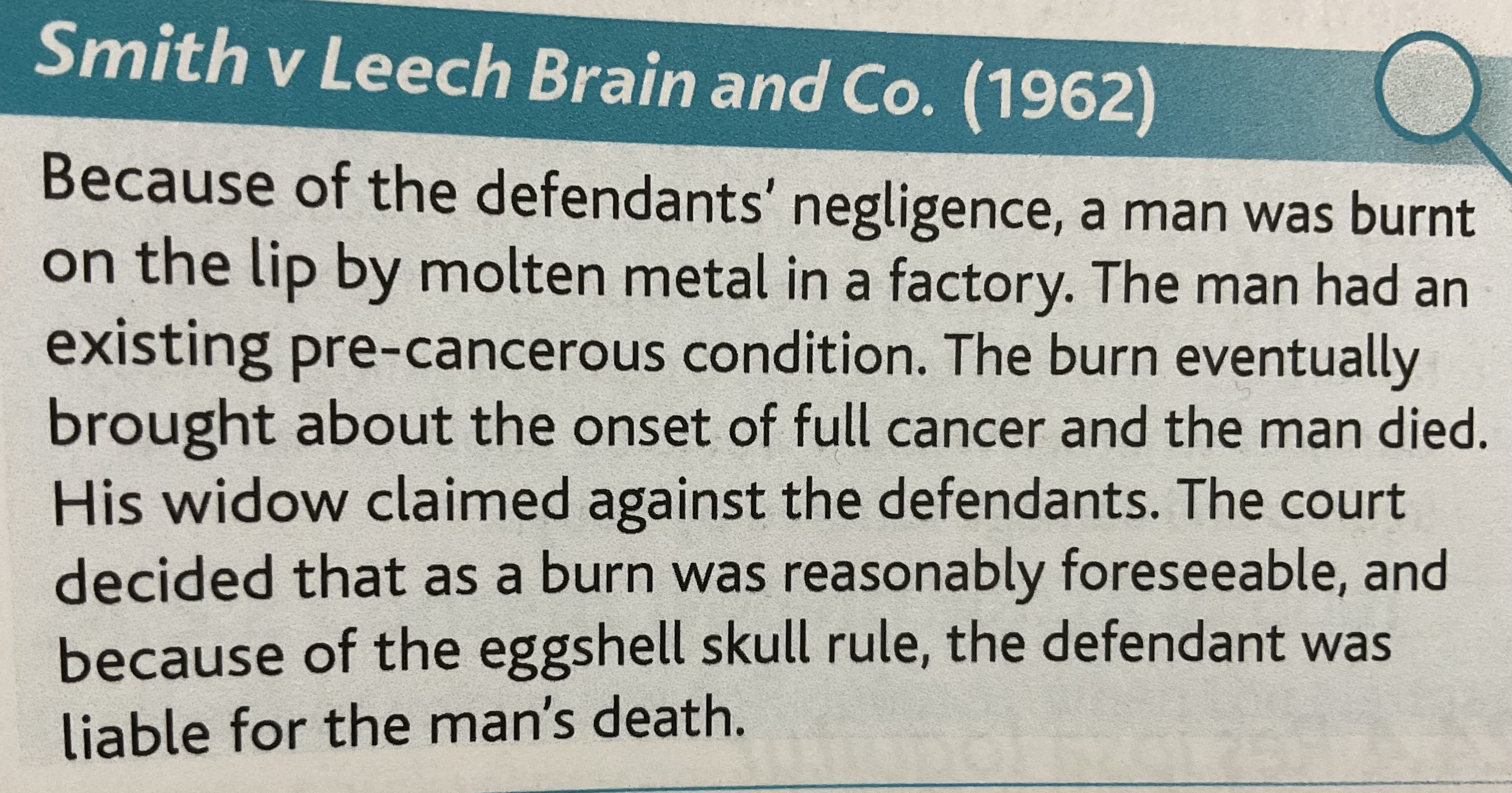
Res Ipsa loquitur
The thing speaks for itself
When claimant unsure how damage came about
Clamaint has to show
D was in control of the situation which caused the injury
The accident would not have happened unless someone was negligent
No other explanation for injury
If can prove these points then burden of proof moves to defendant
Scott v London and st Katherine docks 1865
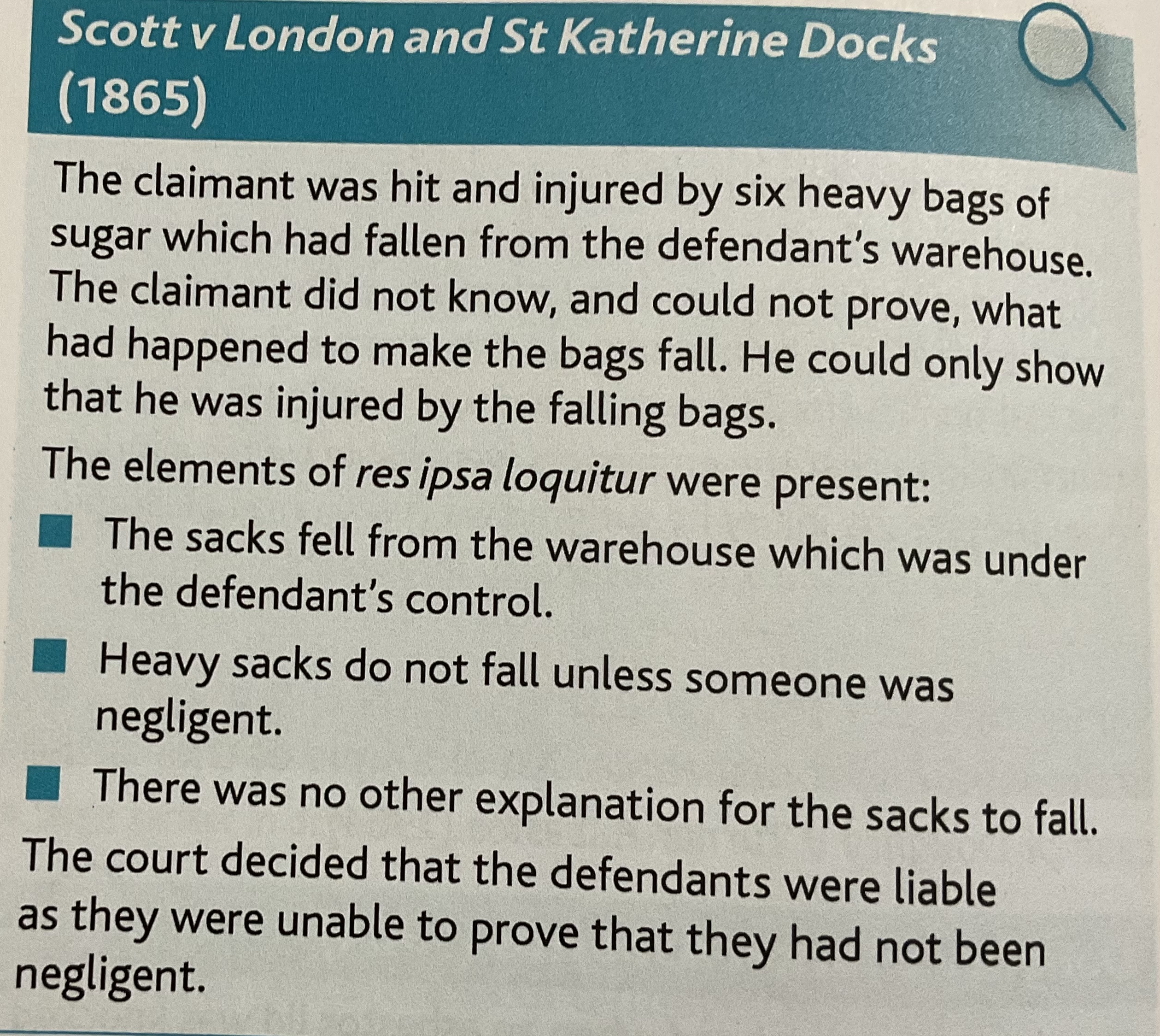
Contributory negligence
Law reform (contributory negligence) act 1945 provides that any damages awarded to claimant can be reduced according to the extent to which the claimant had contributed to their own harm
Amount of blame decided by judge. Judge first sets full amount of damages and then decide the % claimant is responsible and reduce damages by that.
Is only a part defence can only result in reduction of damages
It is impossible for their to be 100% reduction in damages
Sayers v Harlow urban district council 1958
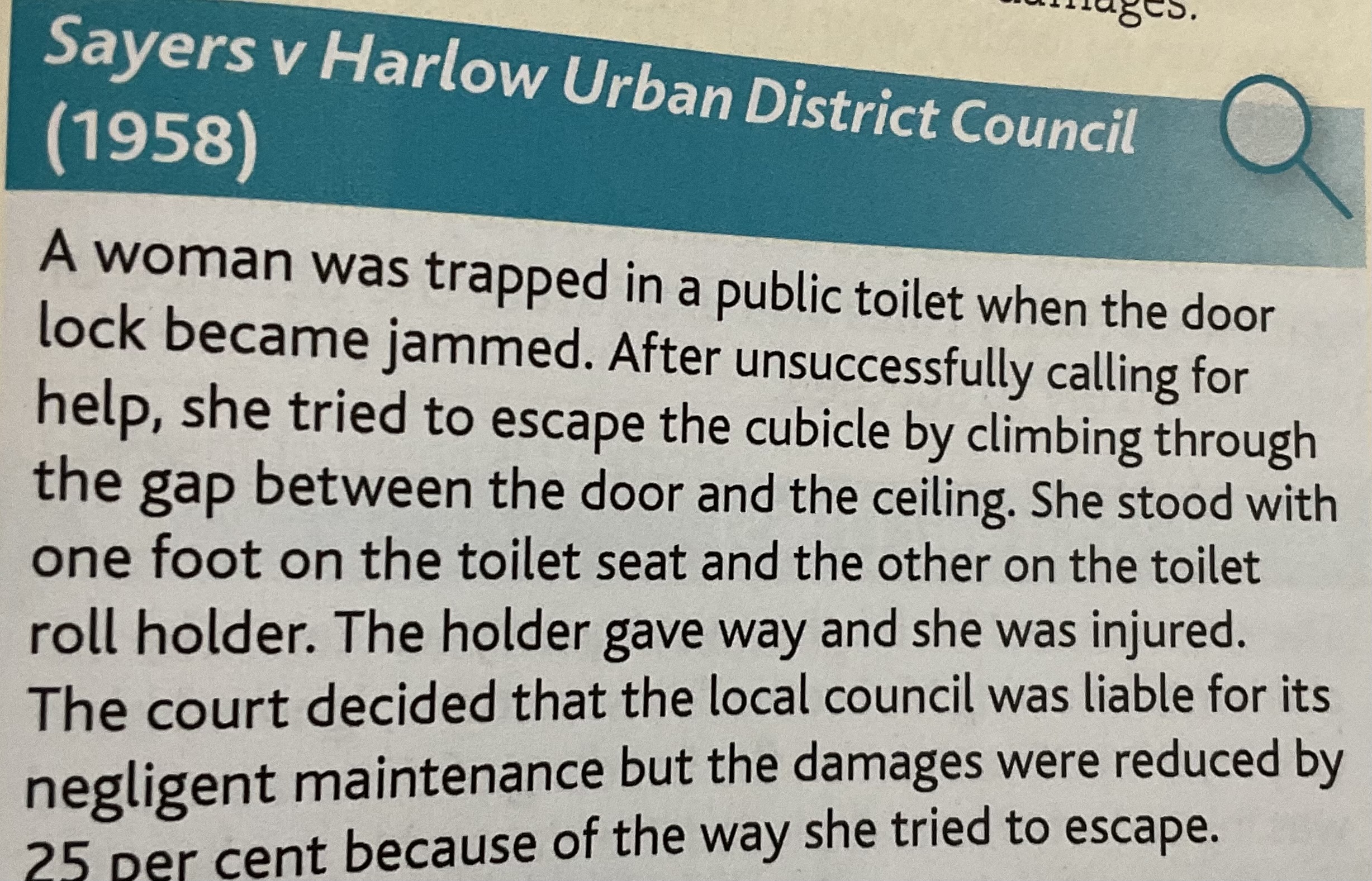
Jayes v IMI (kynoch) ltd 1985
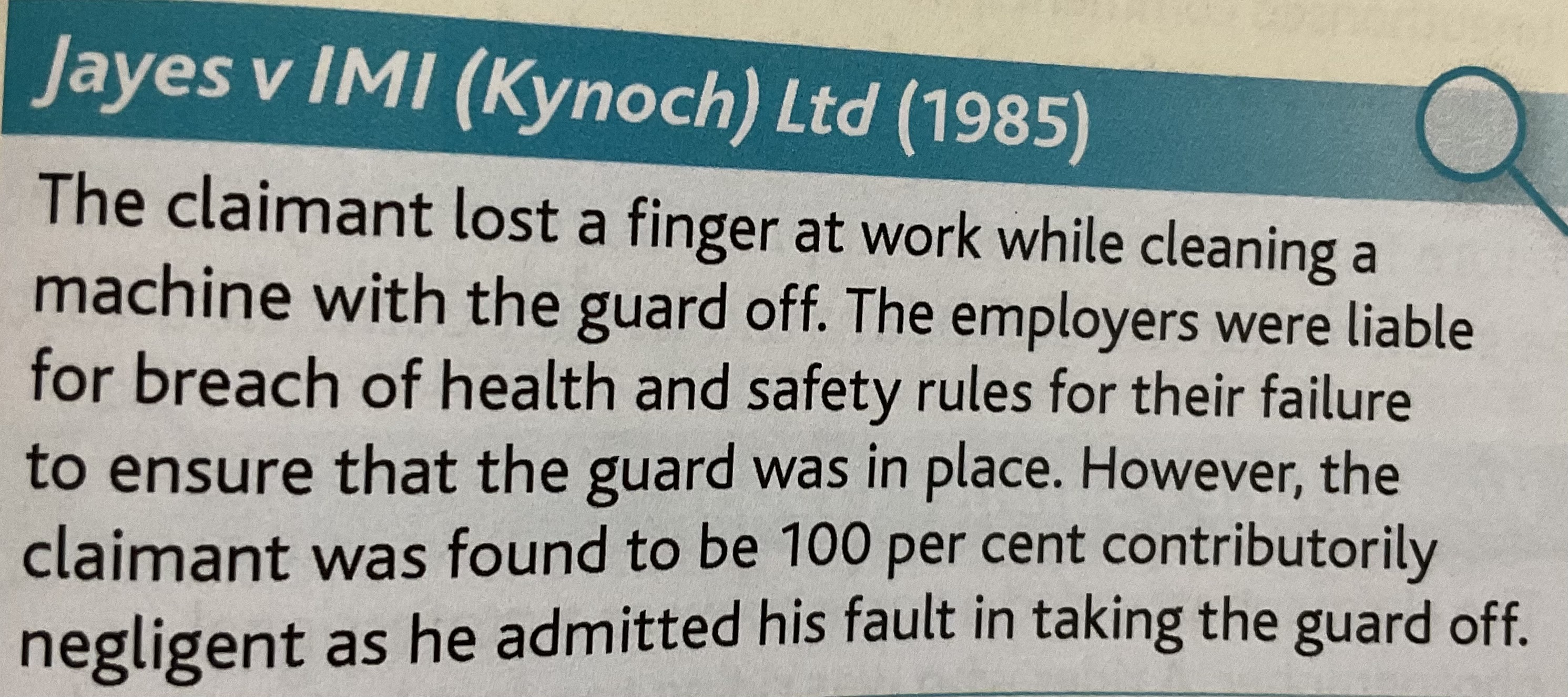
O’Connell v Jackson 1972 and Froom v Butcher 1976
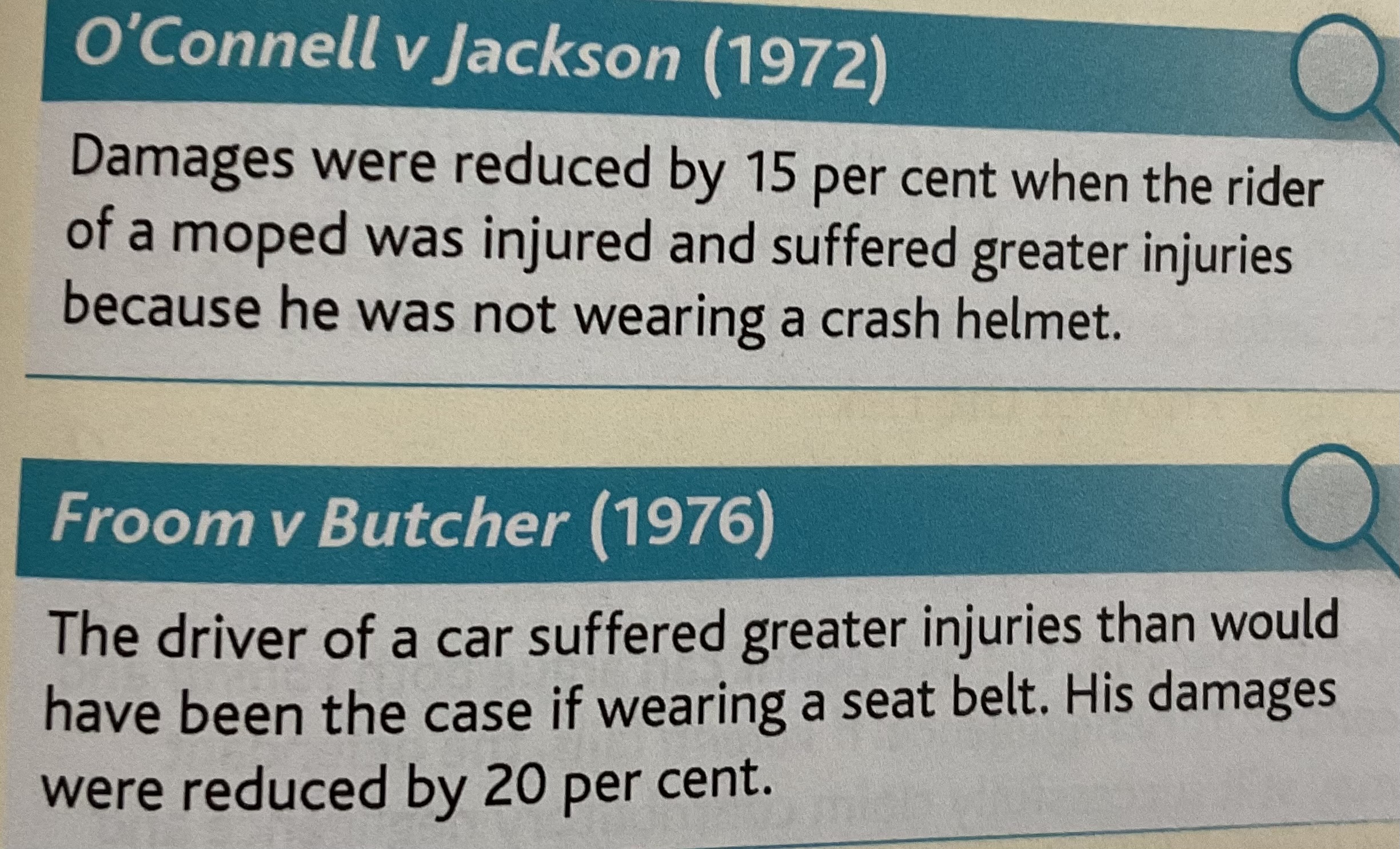
Stanton v Stanton 1993 and badger v ministry of defence 2005
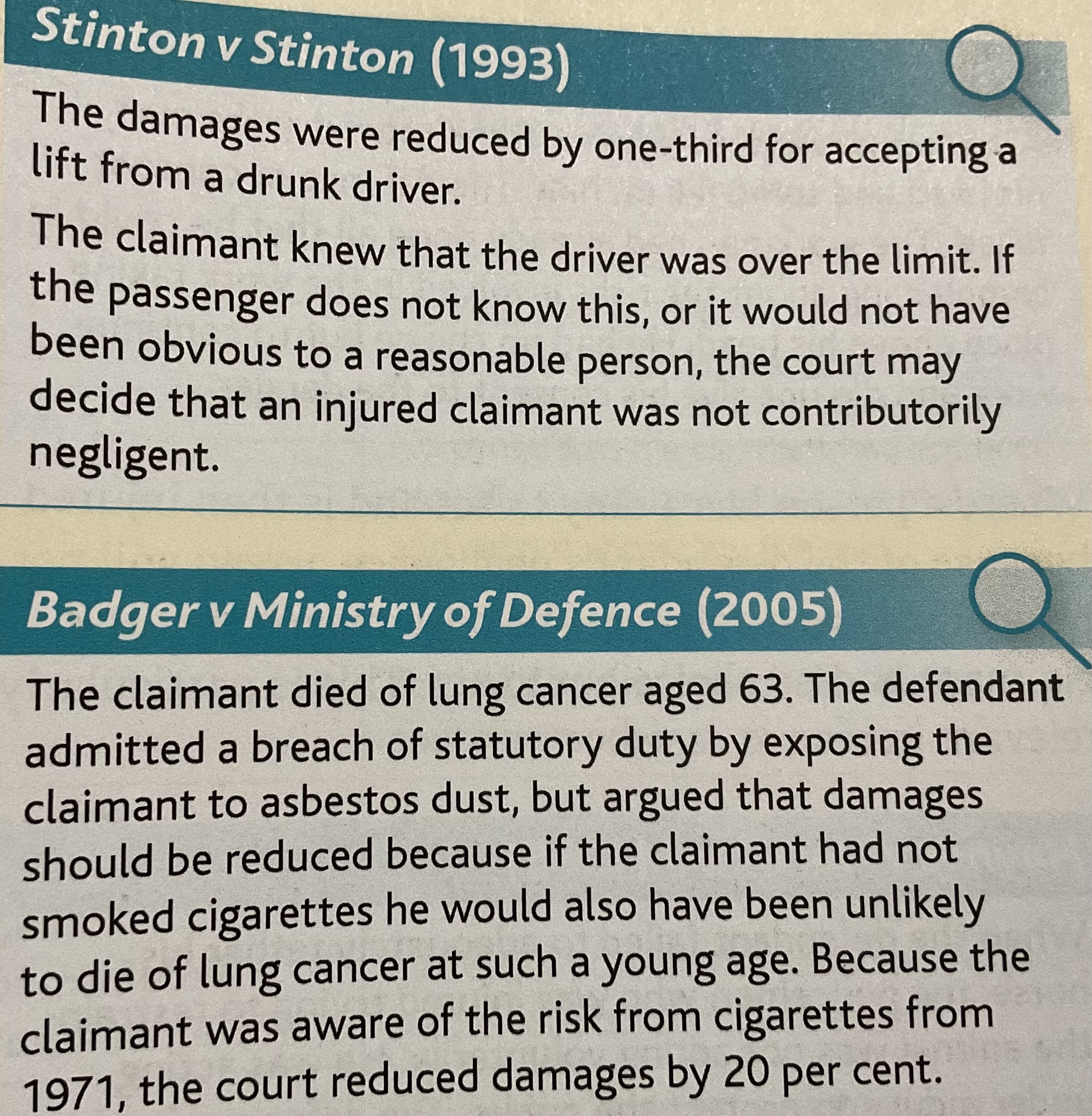
Consent (volenti non fit injuria)
Full defence. No injury is done to one who consents to the risk if successful claimant will receive no damages
To succeed d has to show
Knowledge of the precise risk involved
Exercise of free choice by claimant
A voluntary acceptance of risk
Restriction- s149 of road traffic act 1988 provides that defence cannot be used for road traffic accidents
Defence wont apply just bc c knows of risk they must understand full nature of risks
D will not succeed where claimant has no choice but to accept the risk
Where a person has a duty to act and is then injured bc of d’s negligence volenti will not be available as defence
If claimant acts against employers orders or against statutory rules and is injured the d of volenti is likely to succeed
Before the defence can be applied successfully must be shown that d did in fact commit a tort
Subjective test and only applies where claimant actually knows or risk not when d claims they do
Stermer v Lawson

Smith v baker 1891
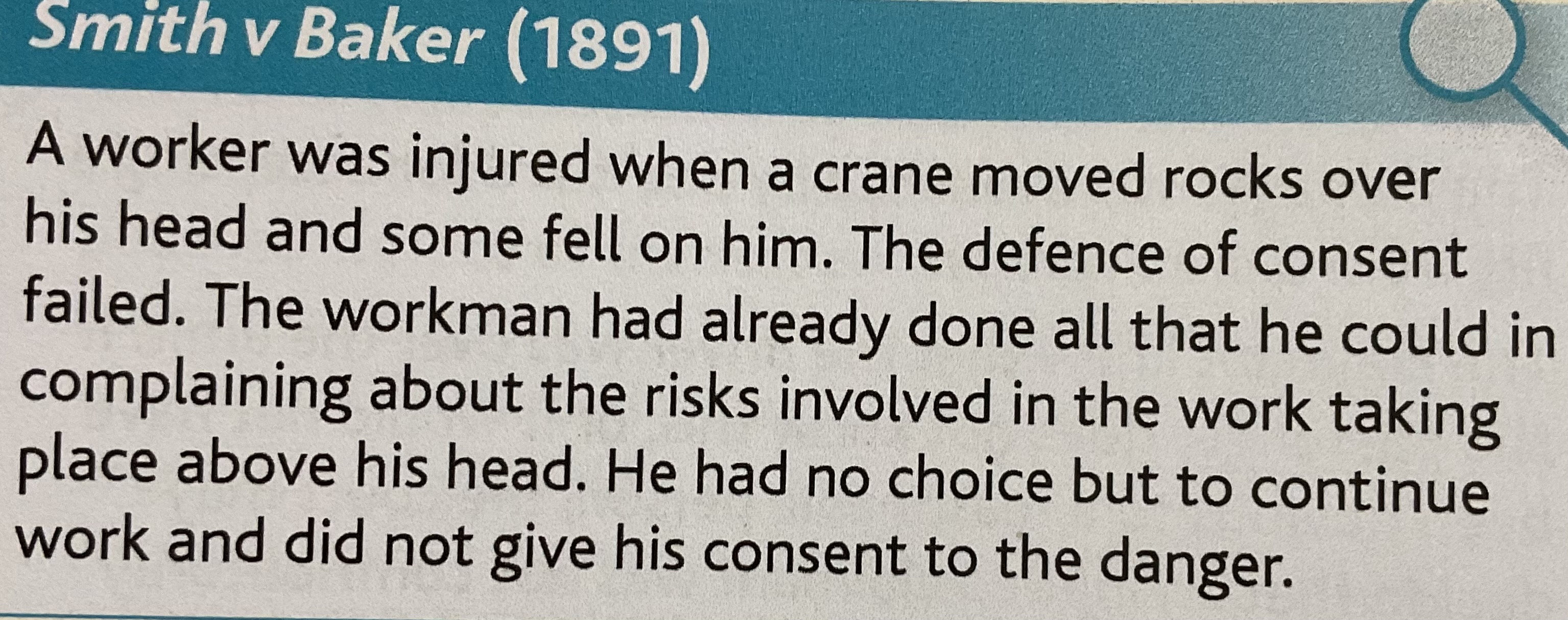
Haynes v harwood 1935
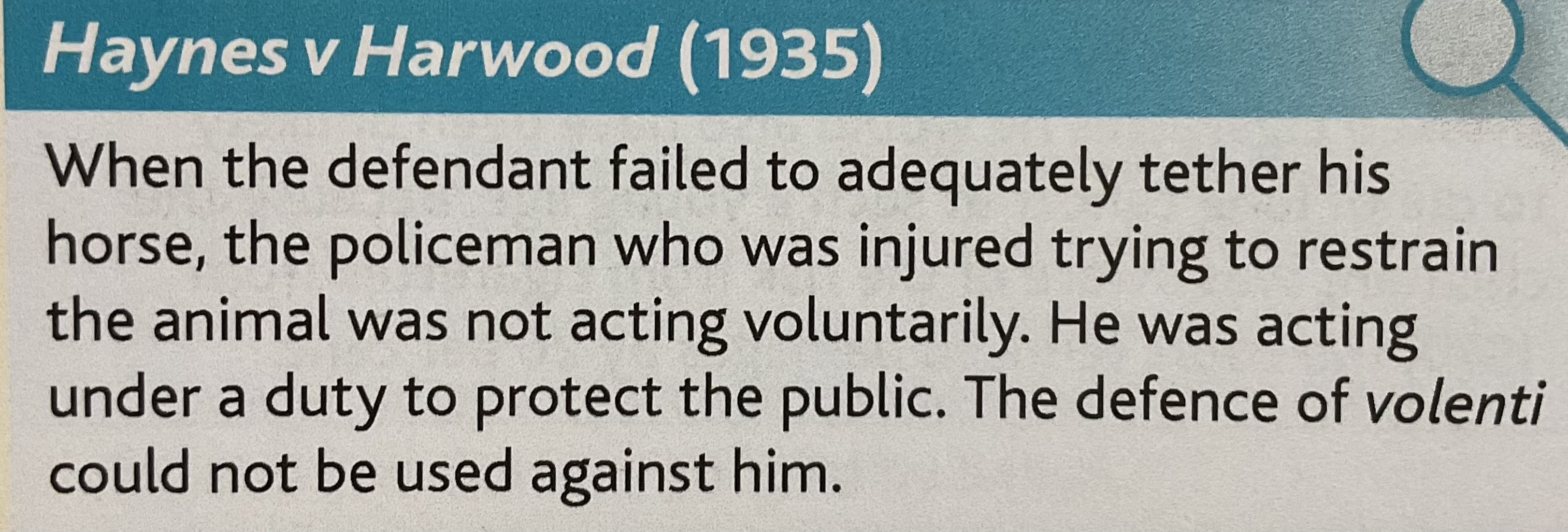
Otto v Taylor 1987
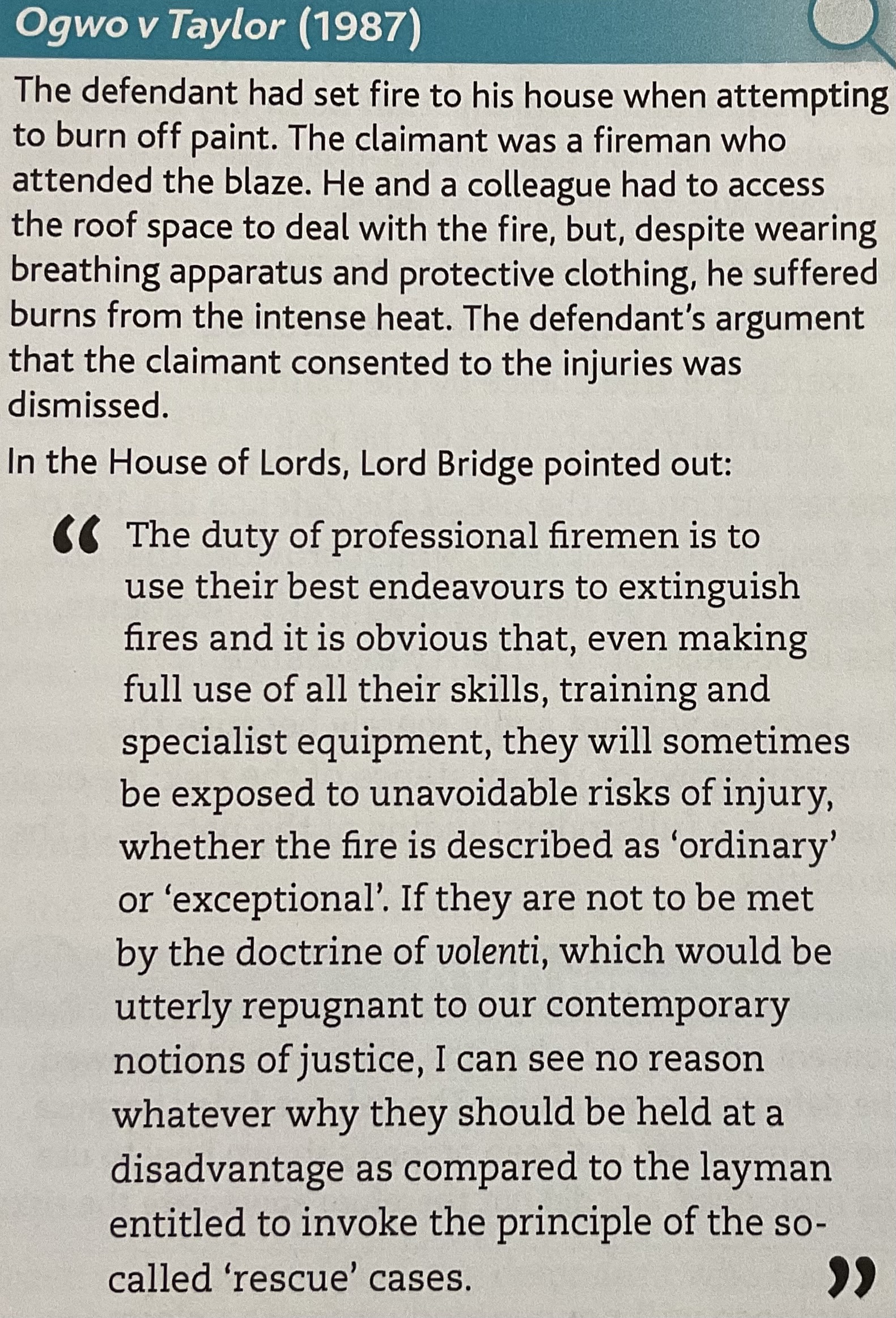
Sidaway v governors of the Bethlehem royal and maudsley hospitals 1985
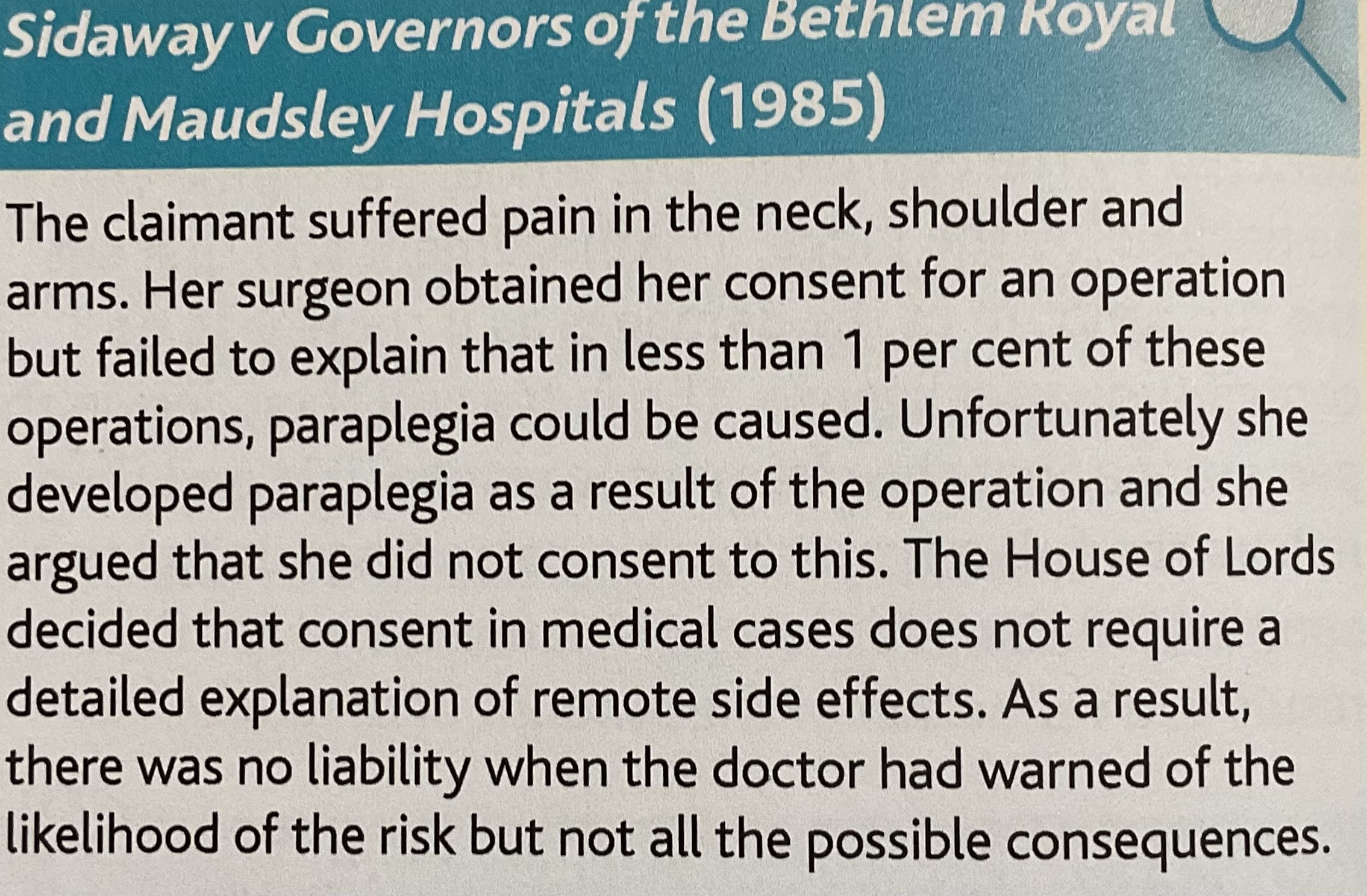
ICI ltd v Shadwell 1965
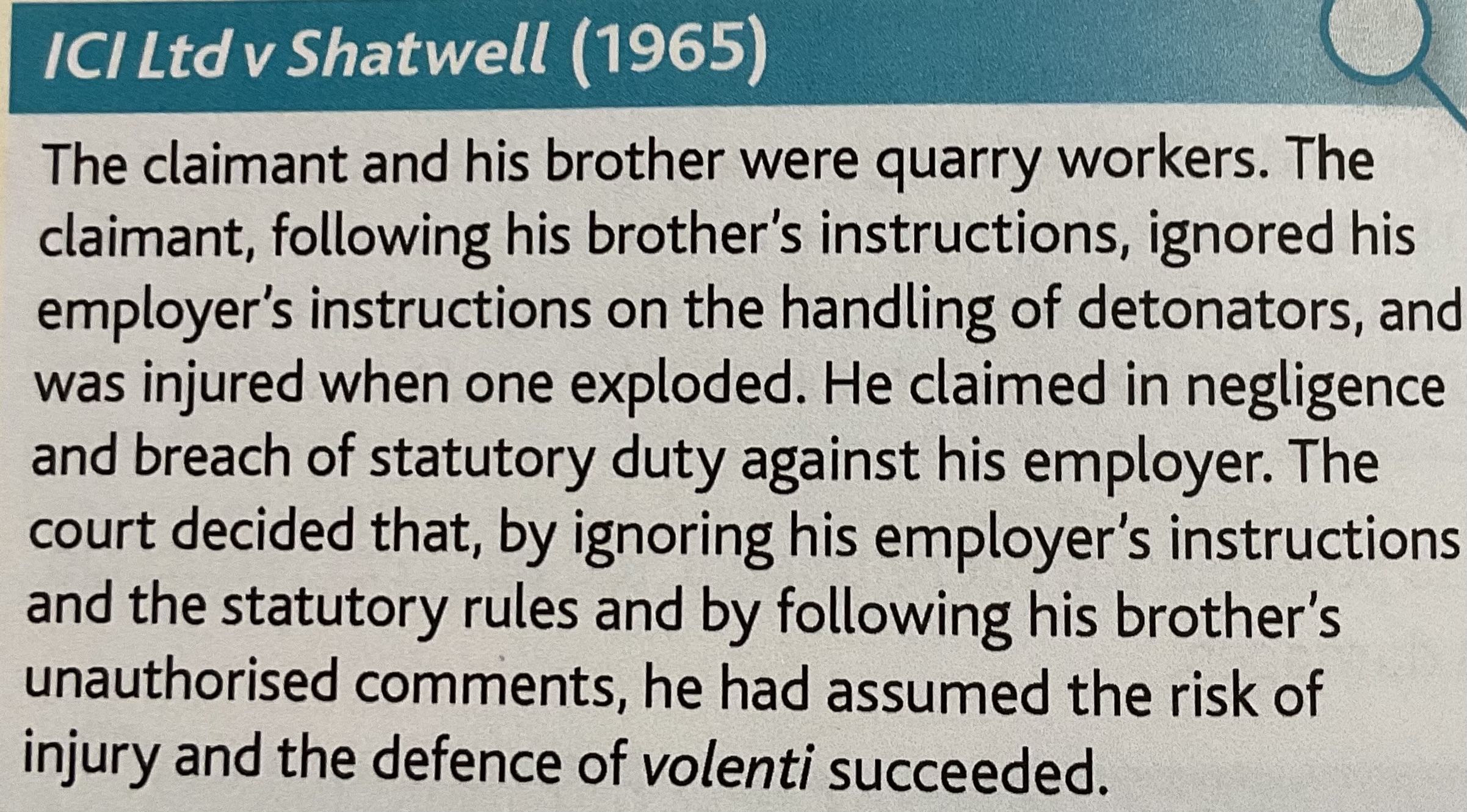
Wooldridge v sumner 1963
